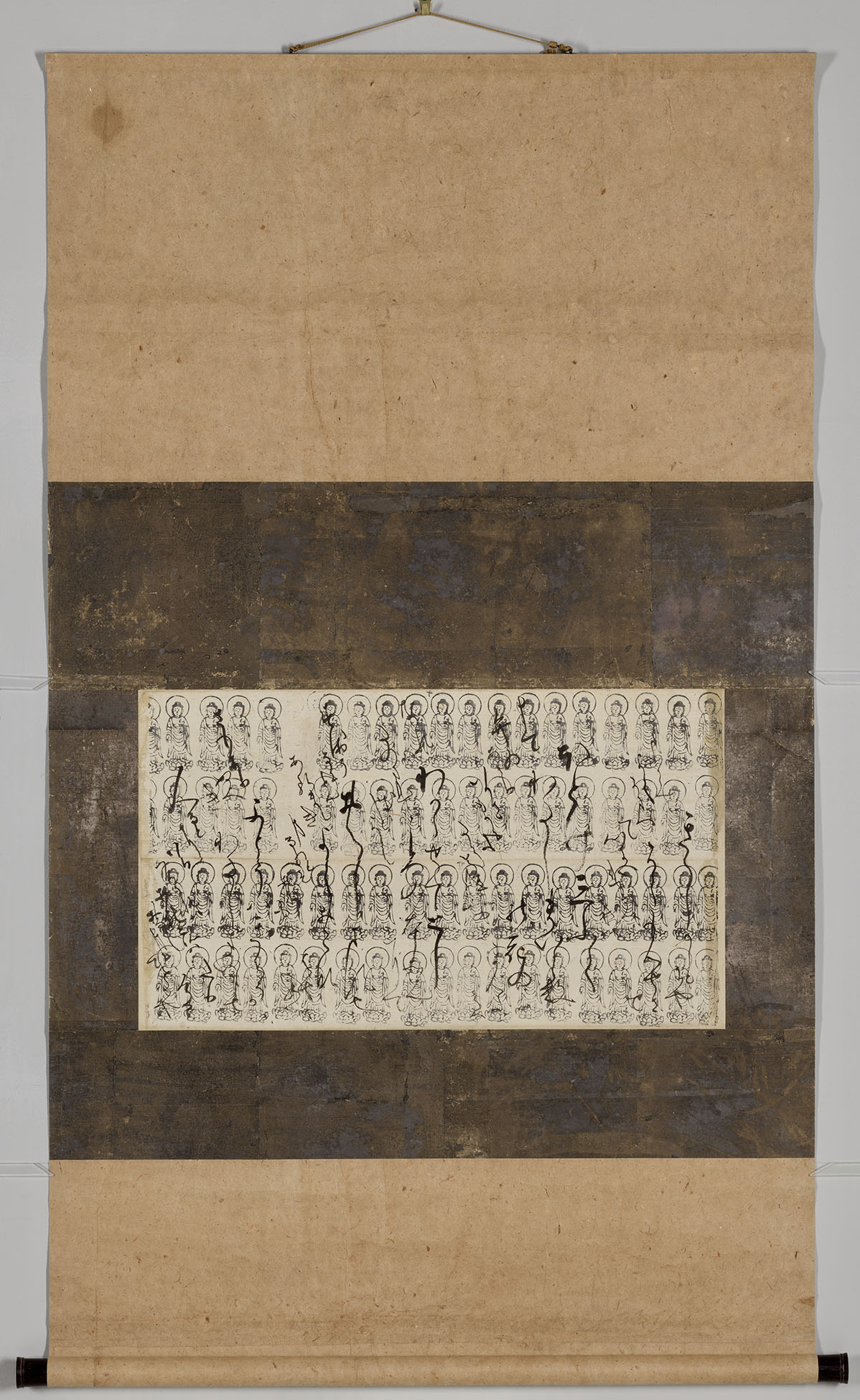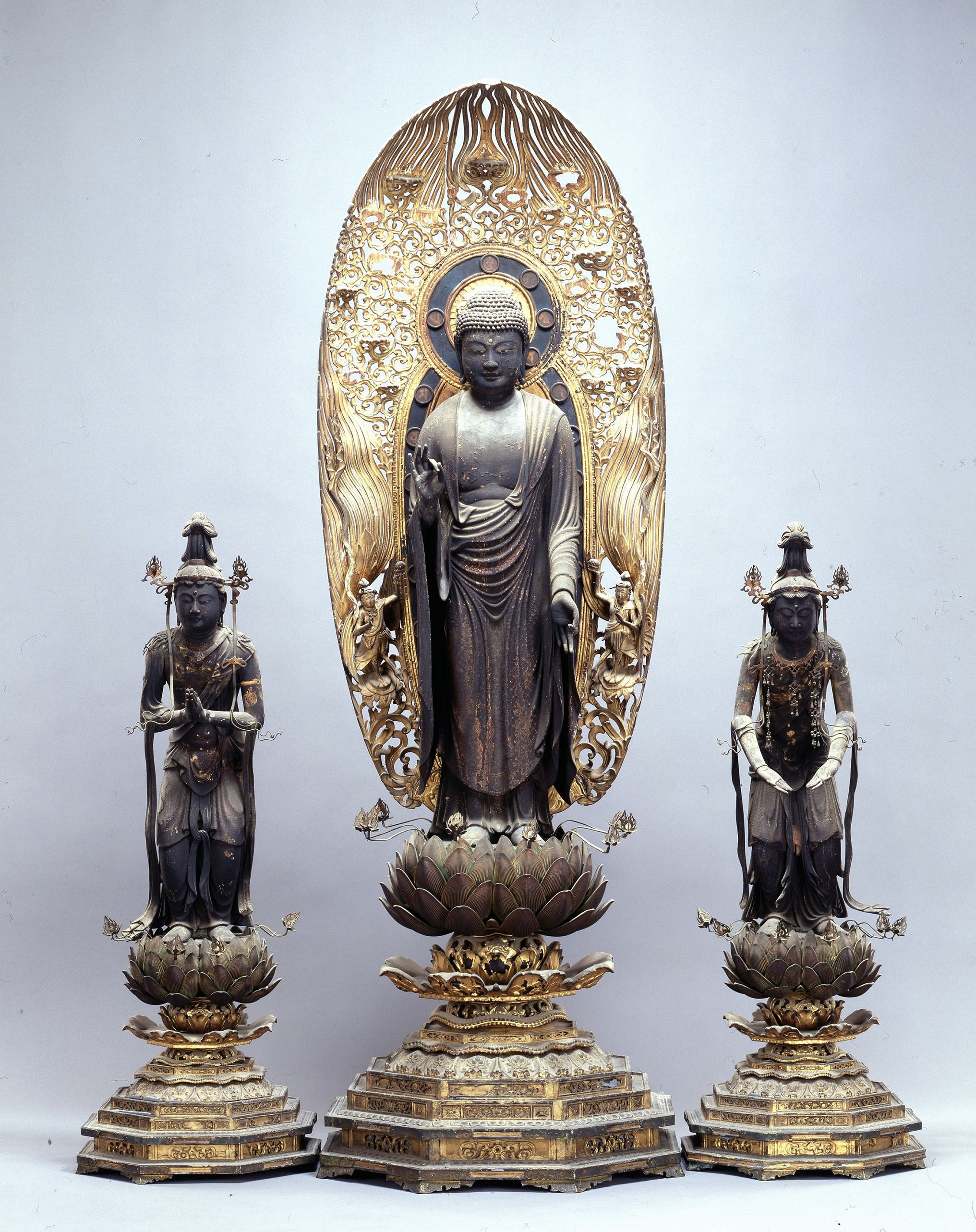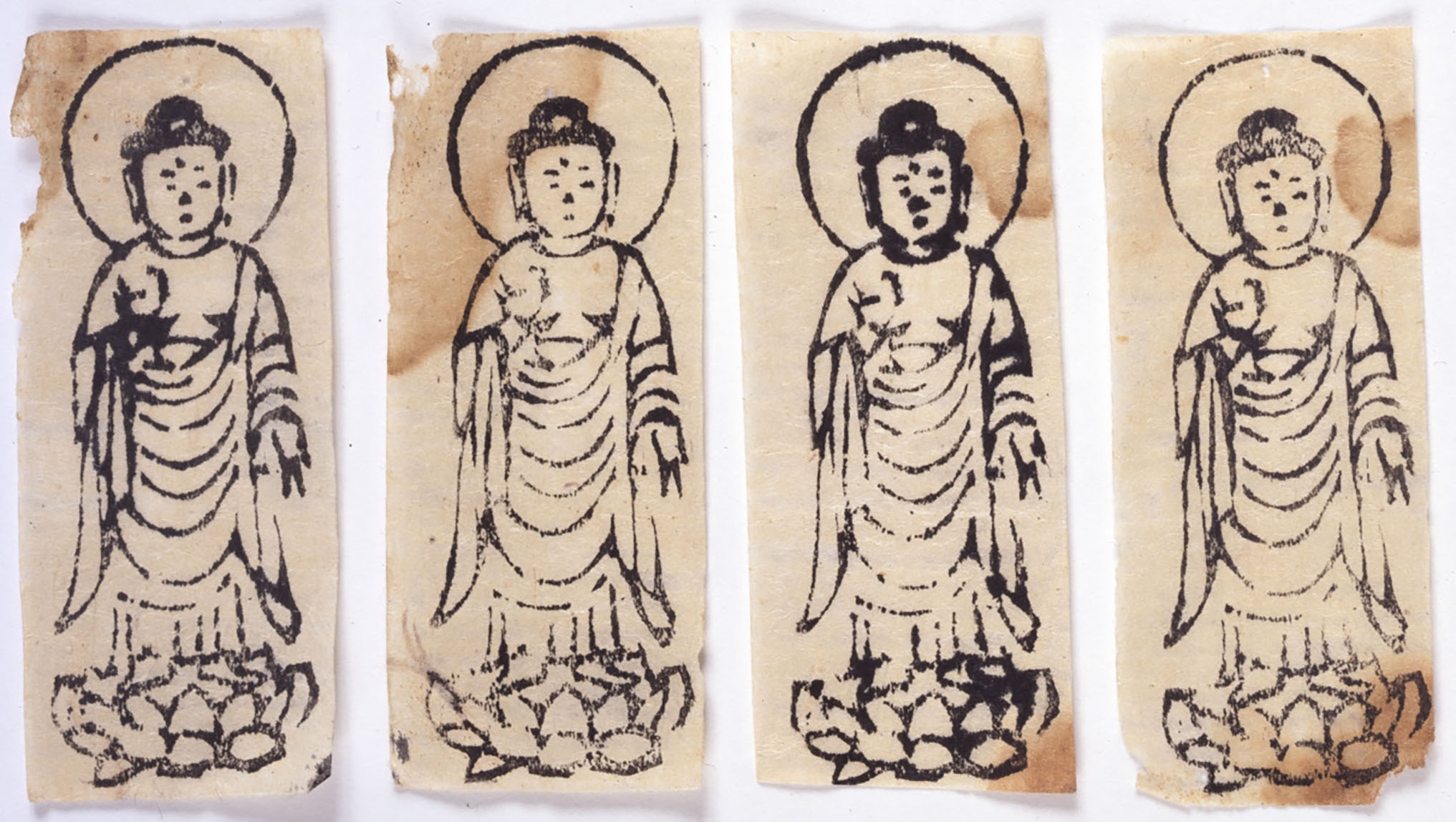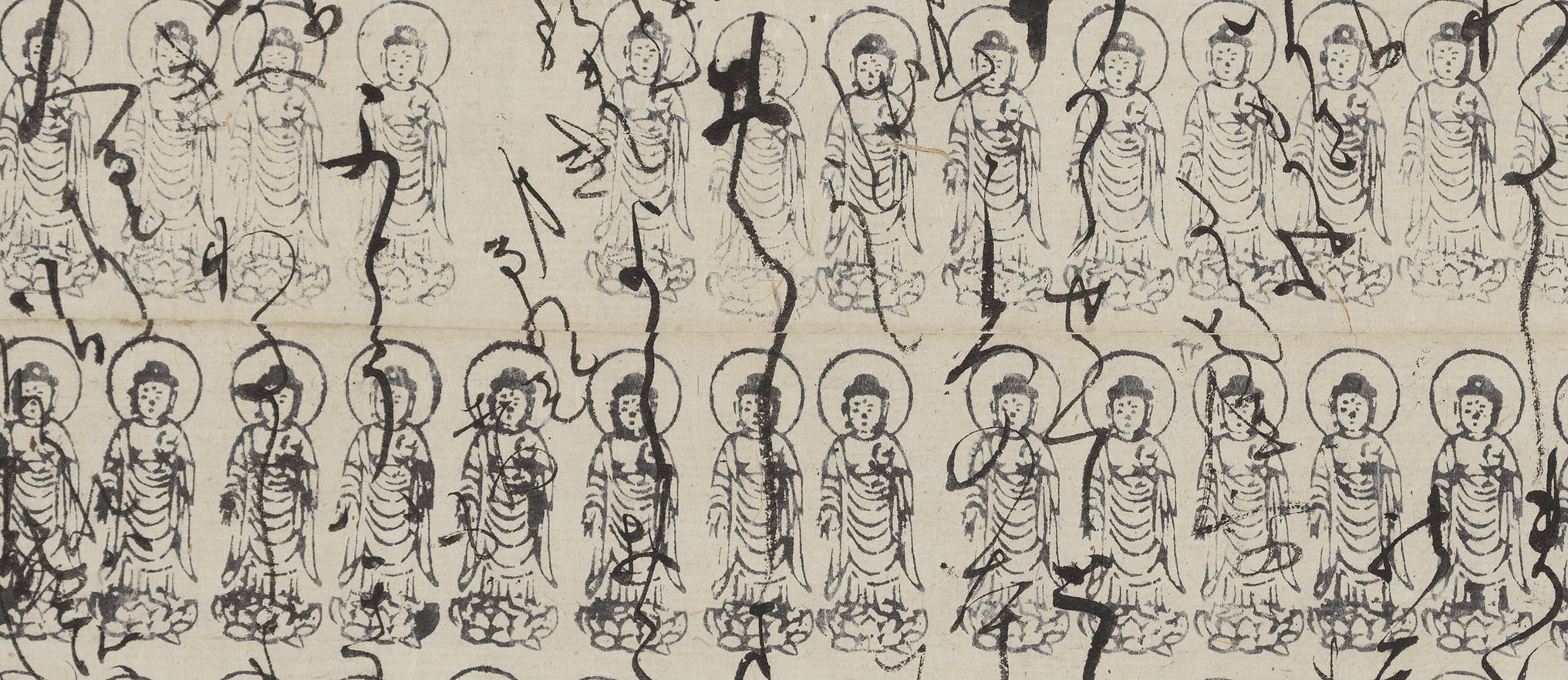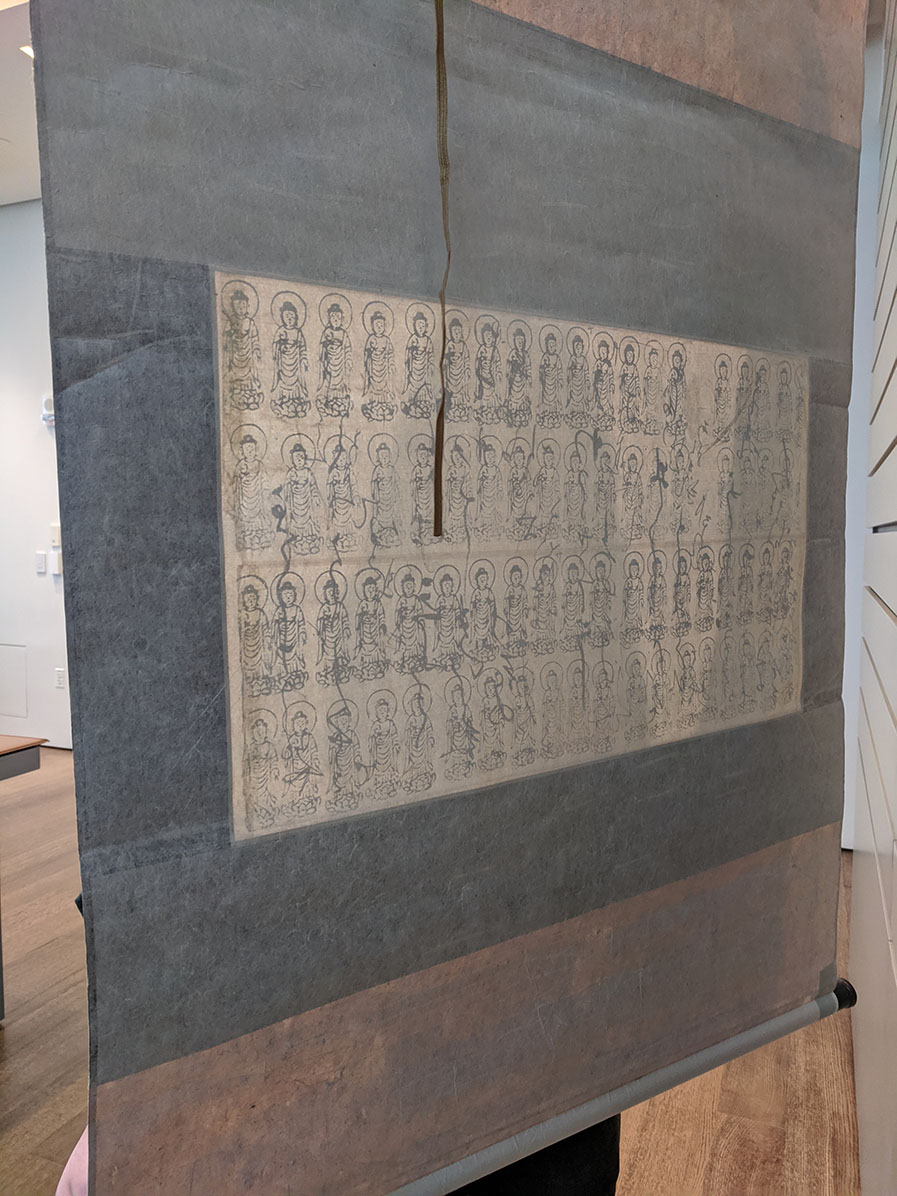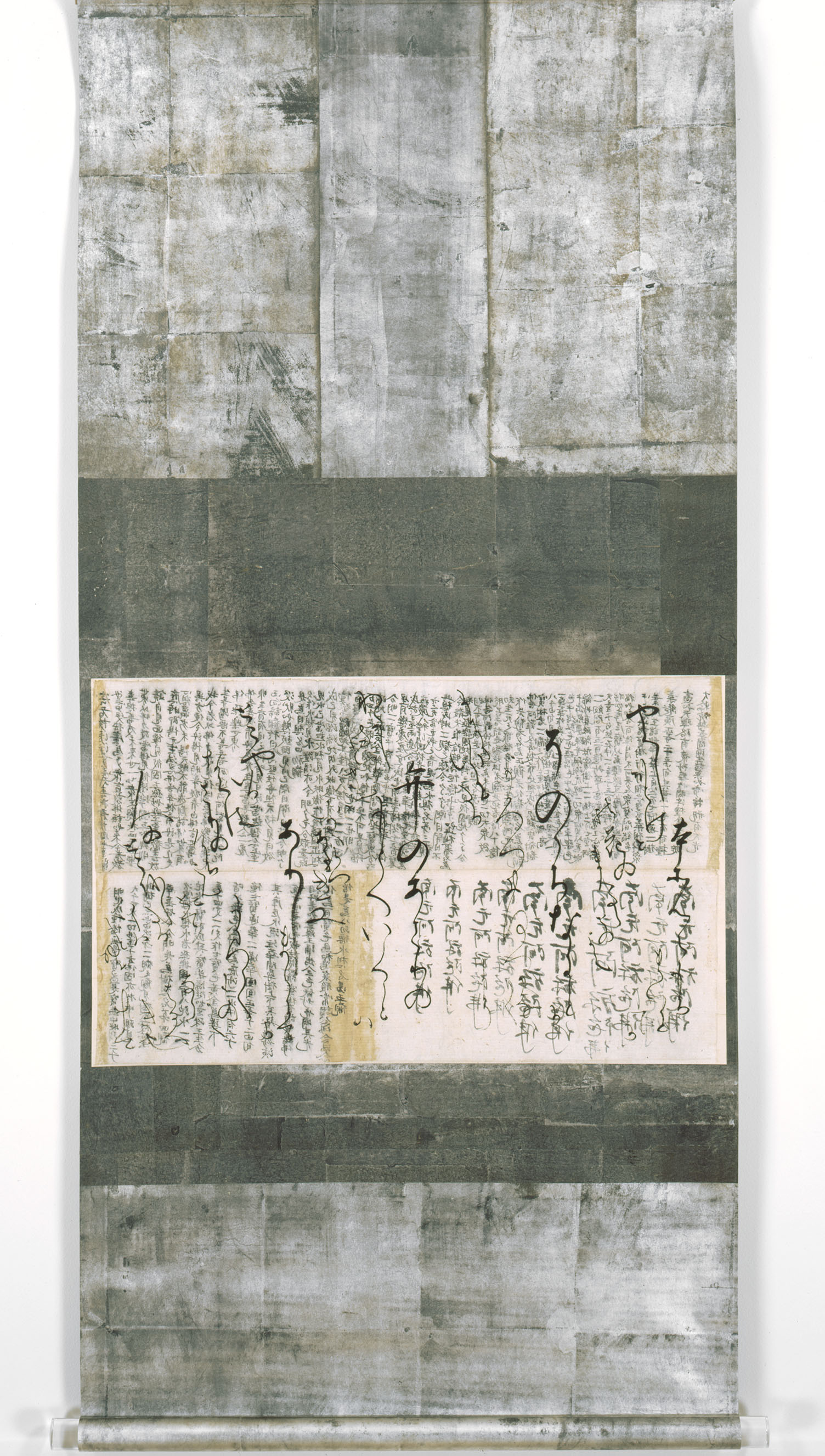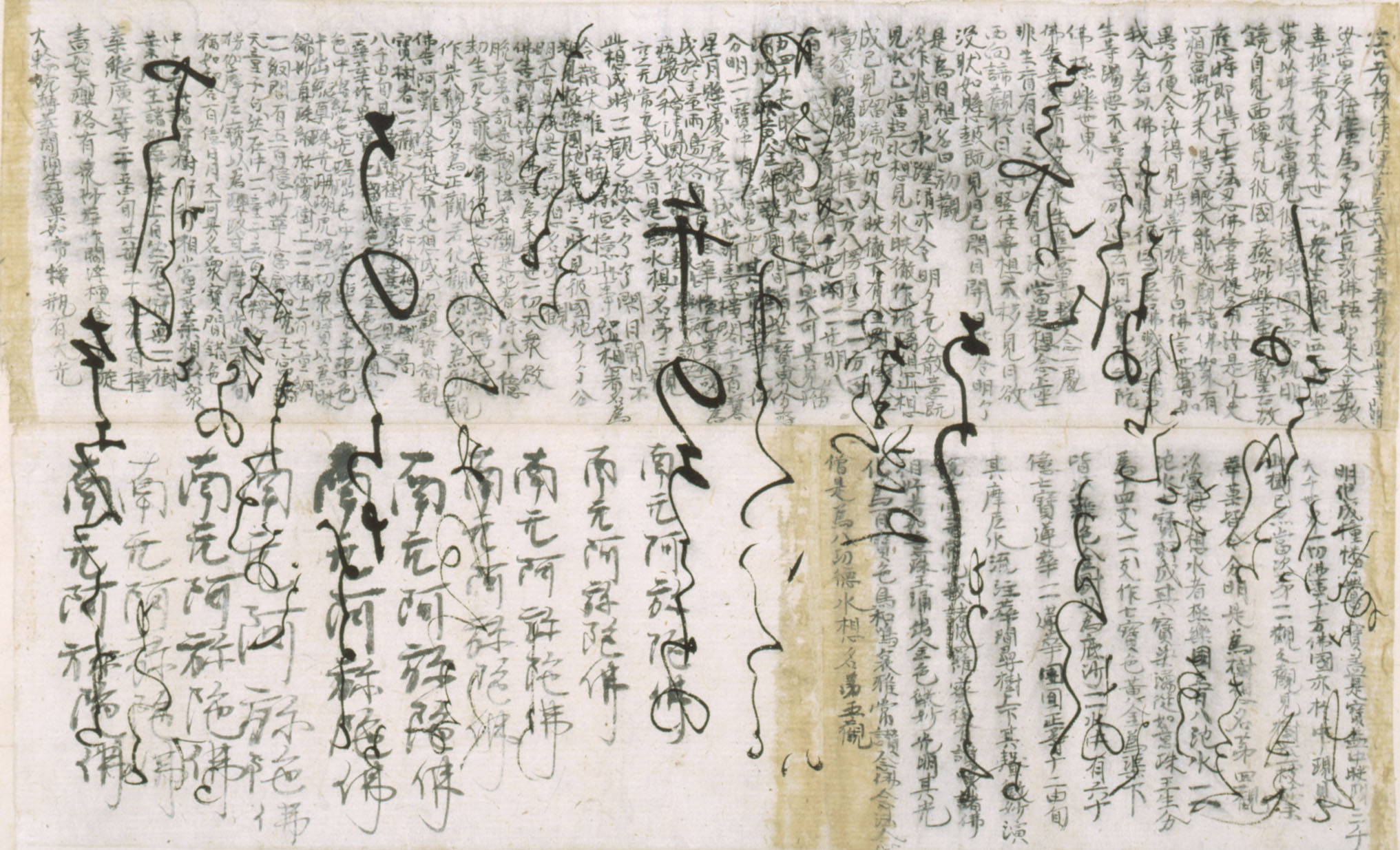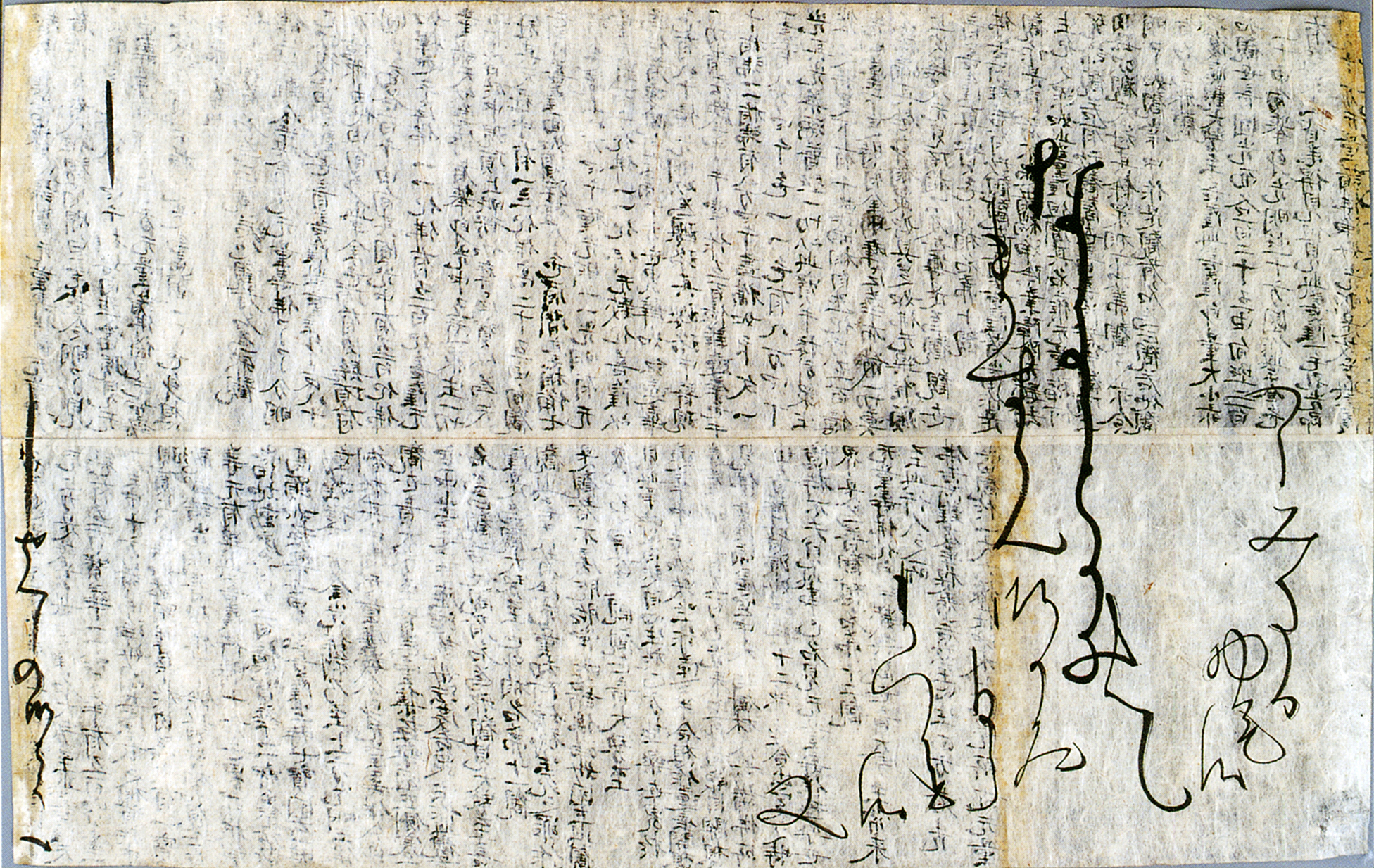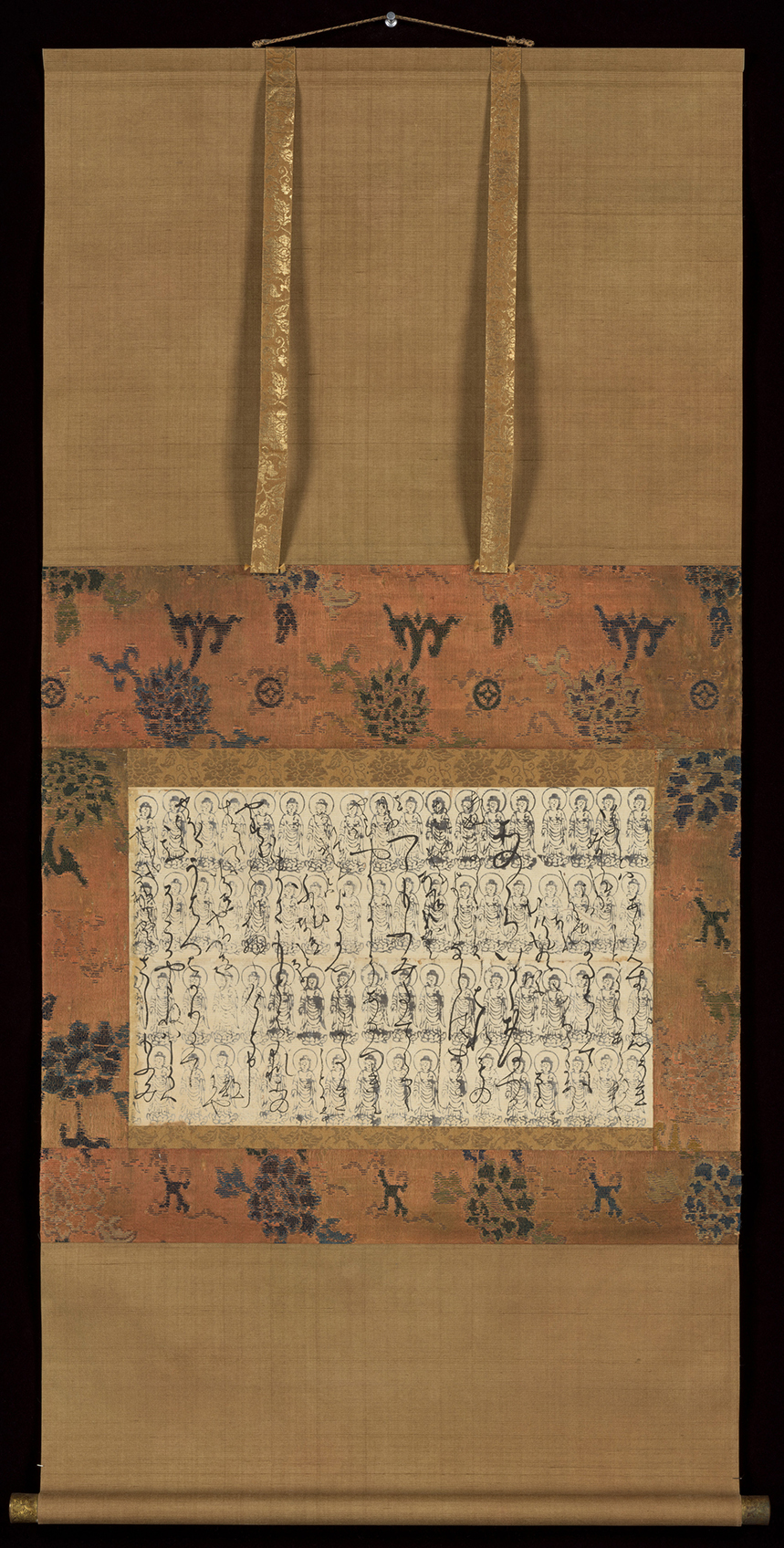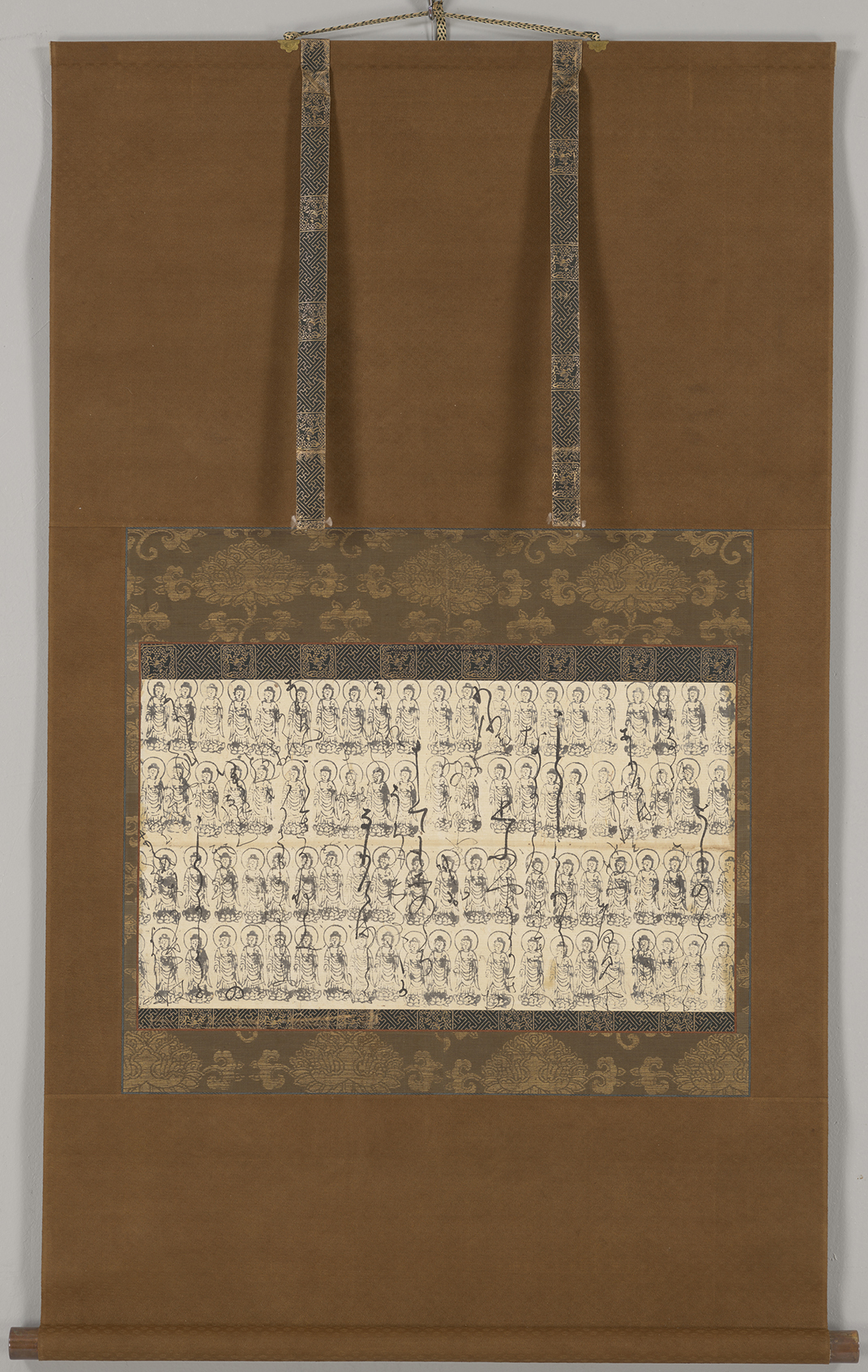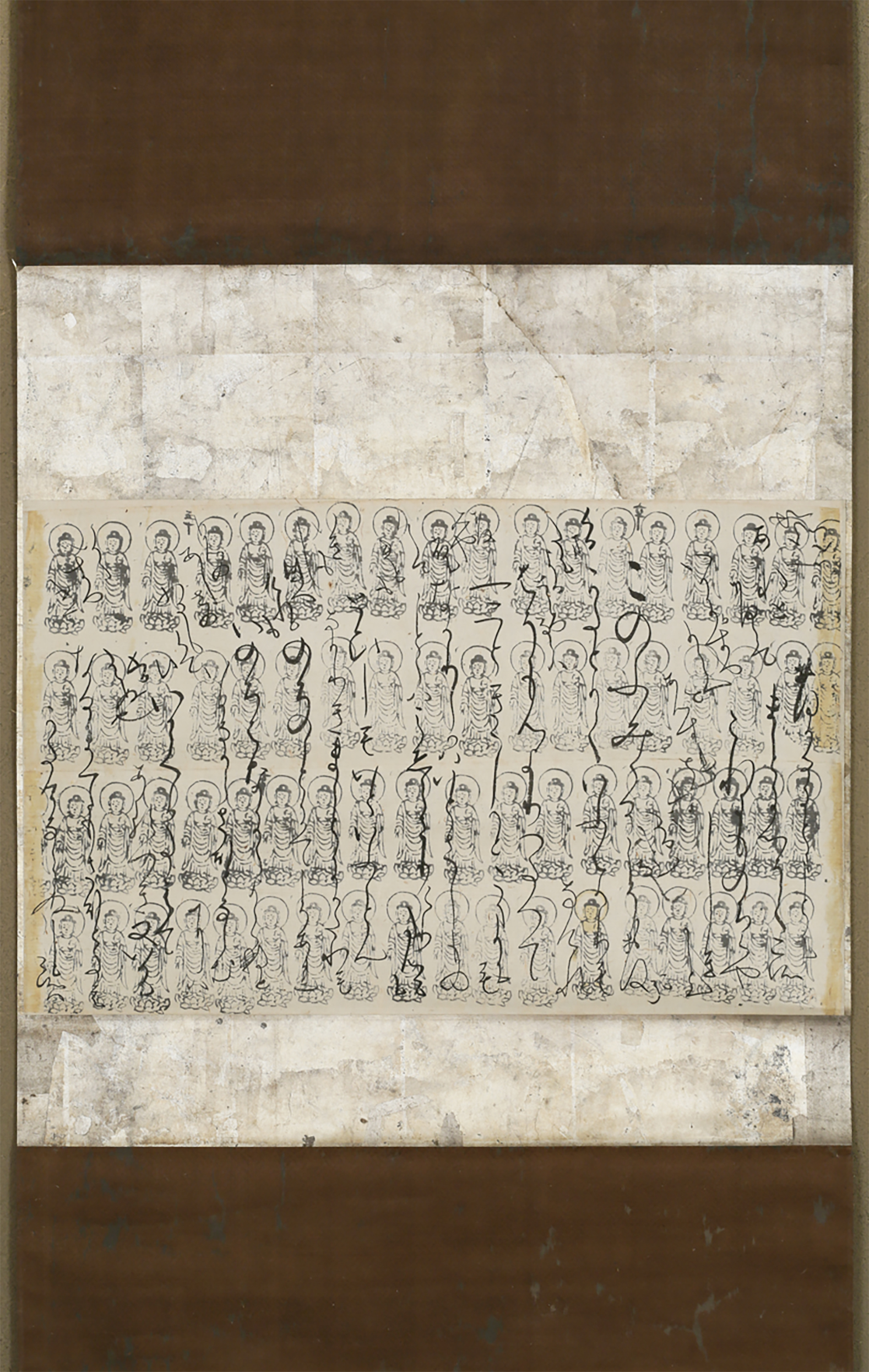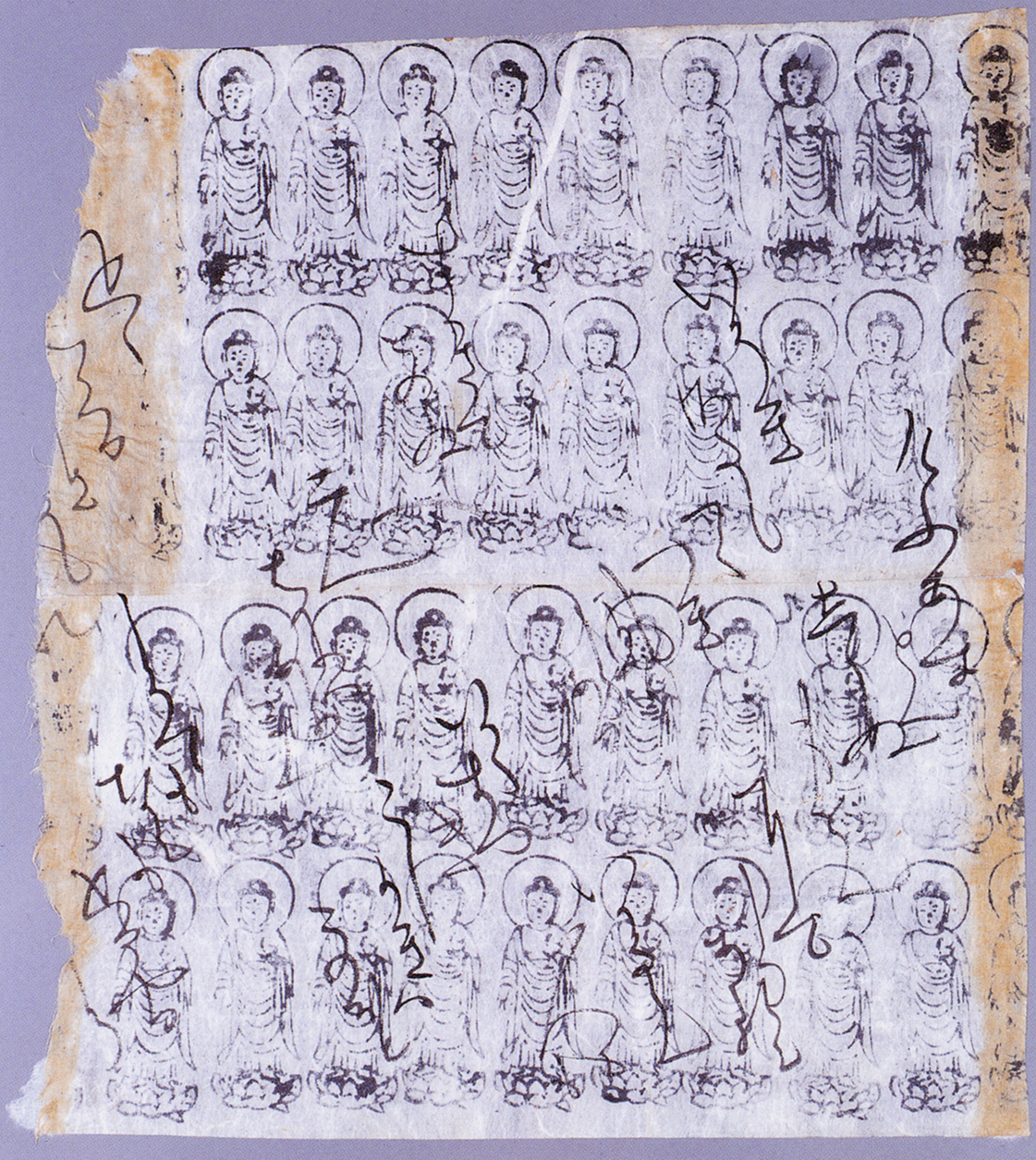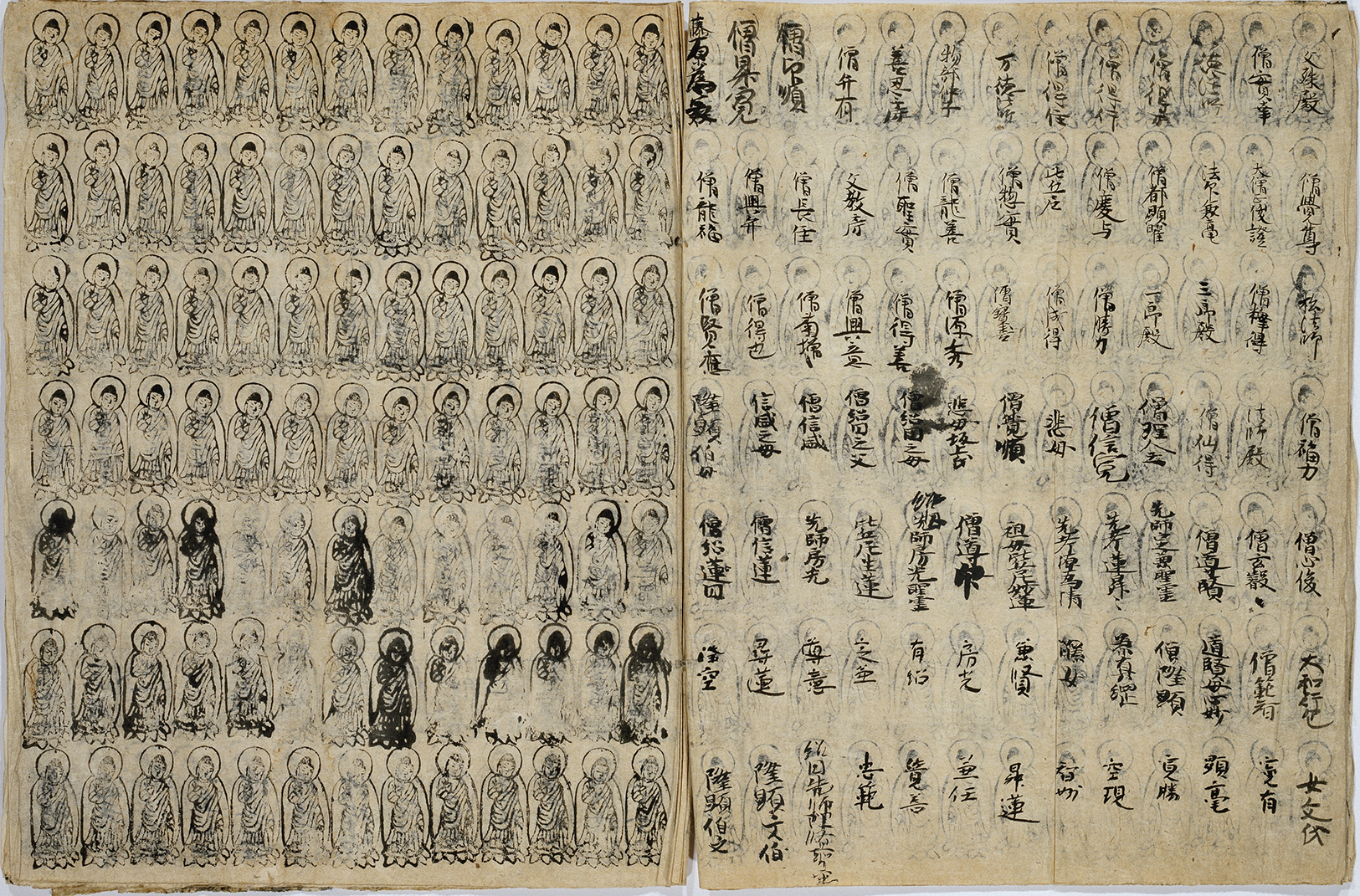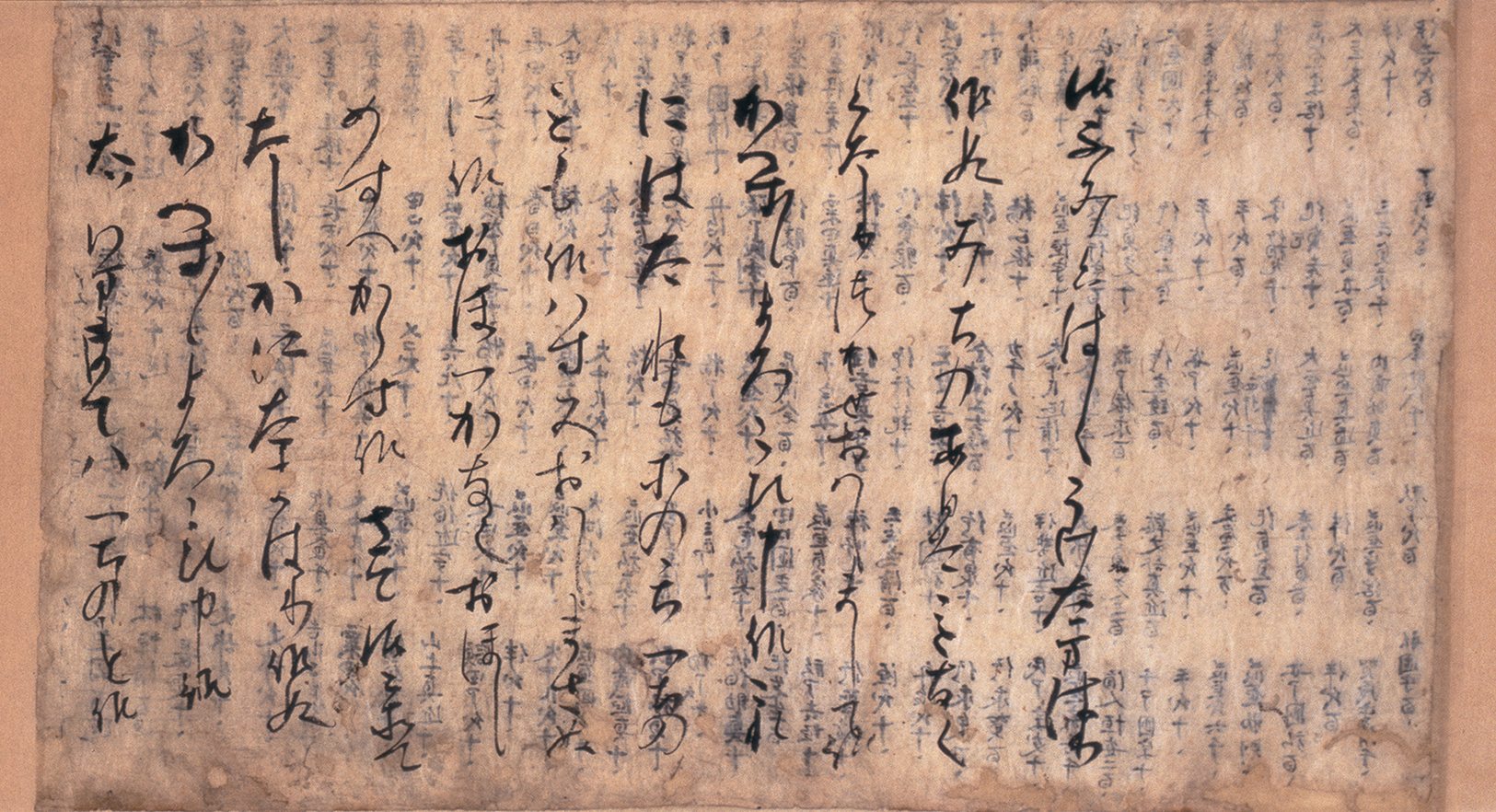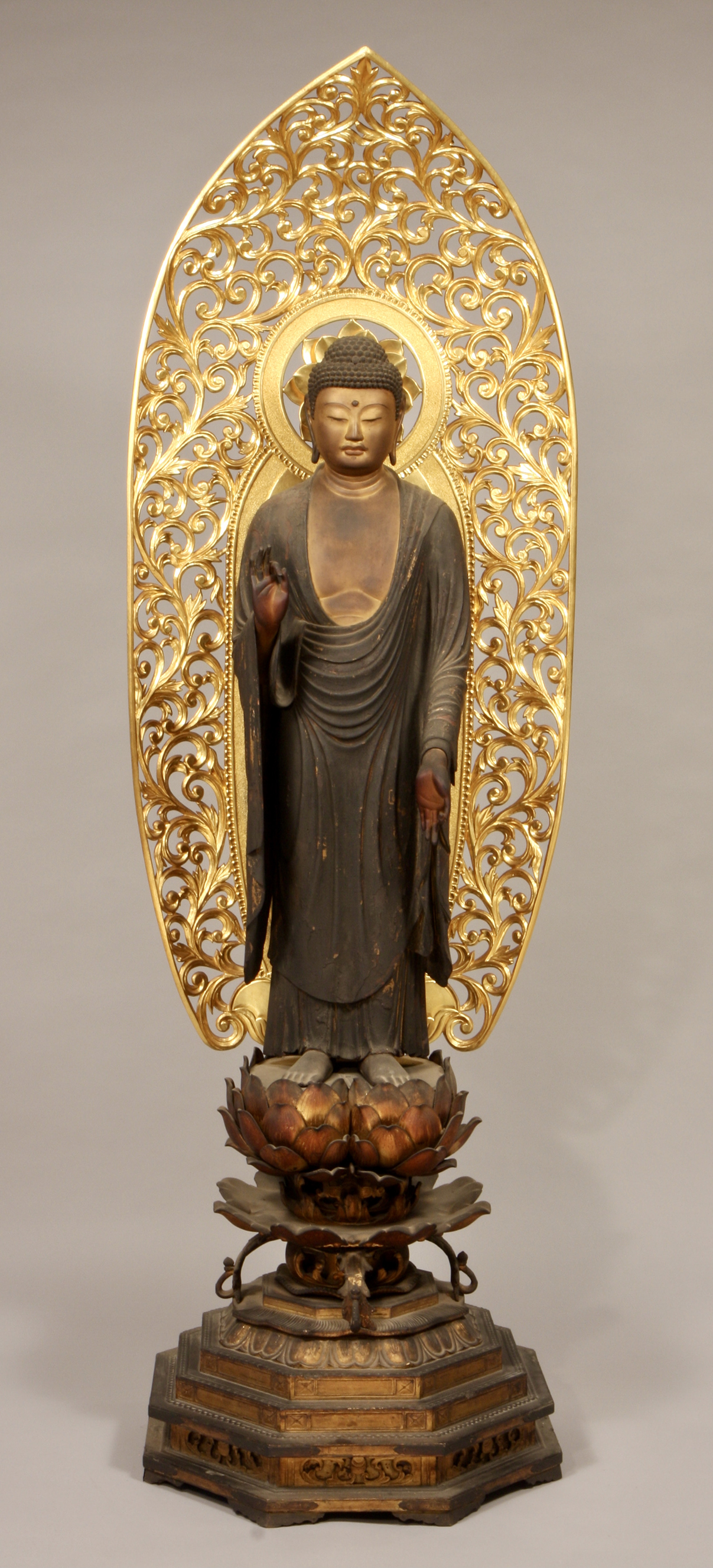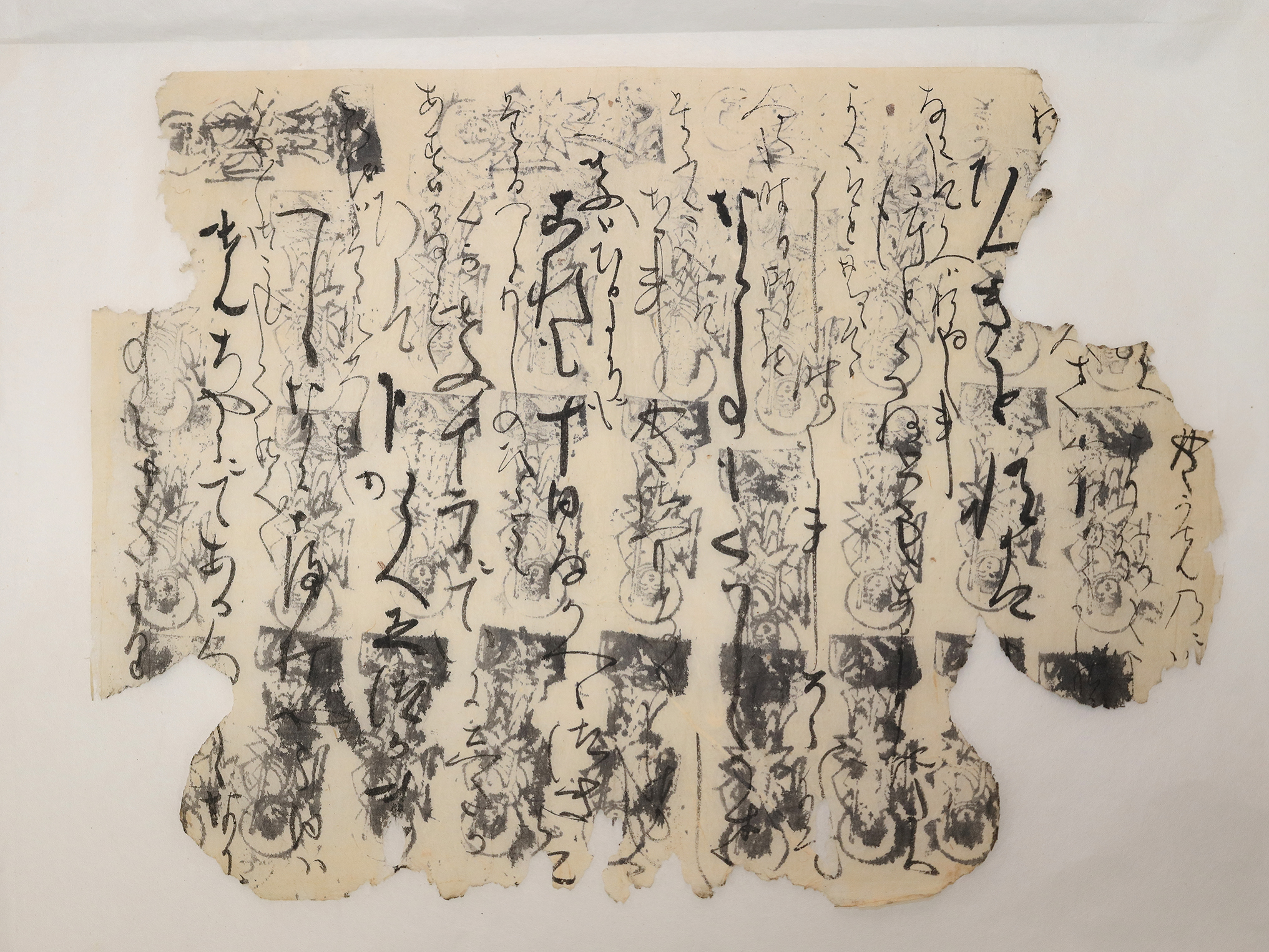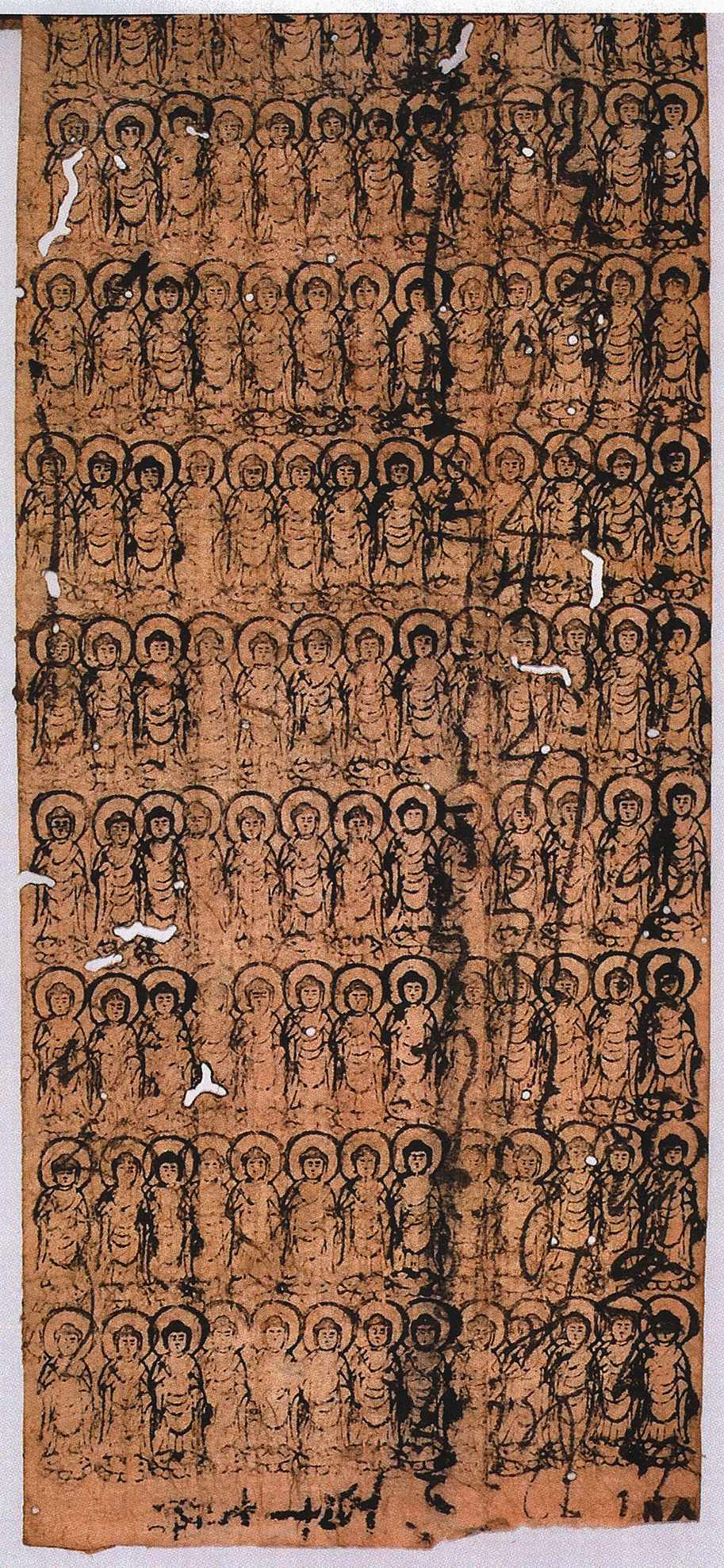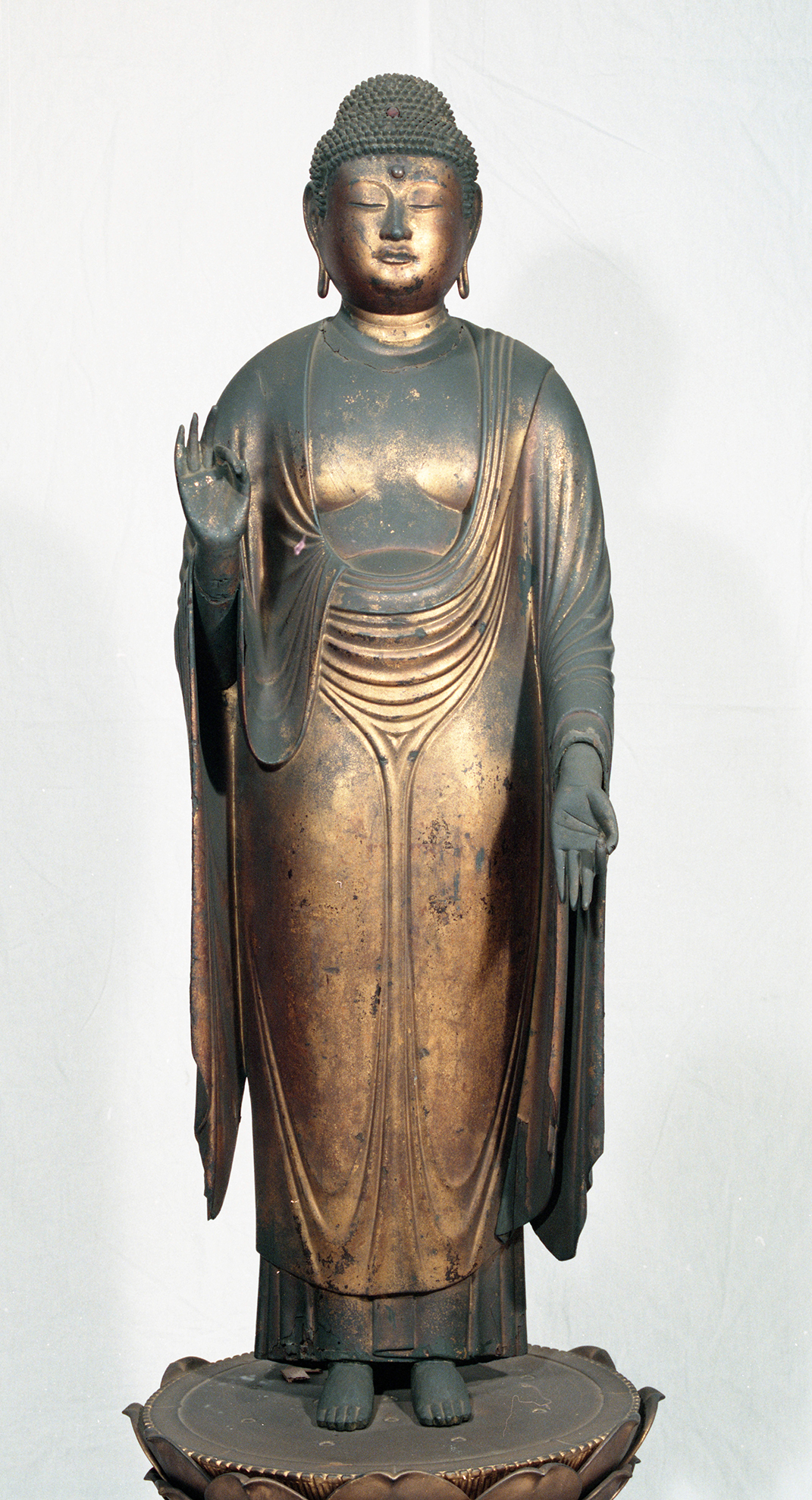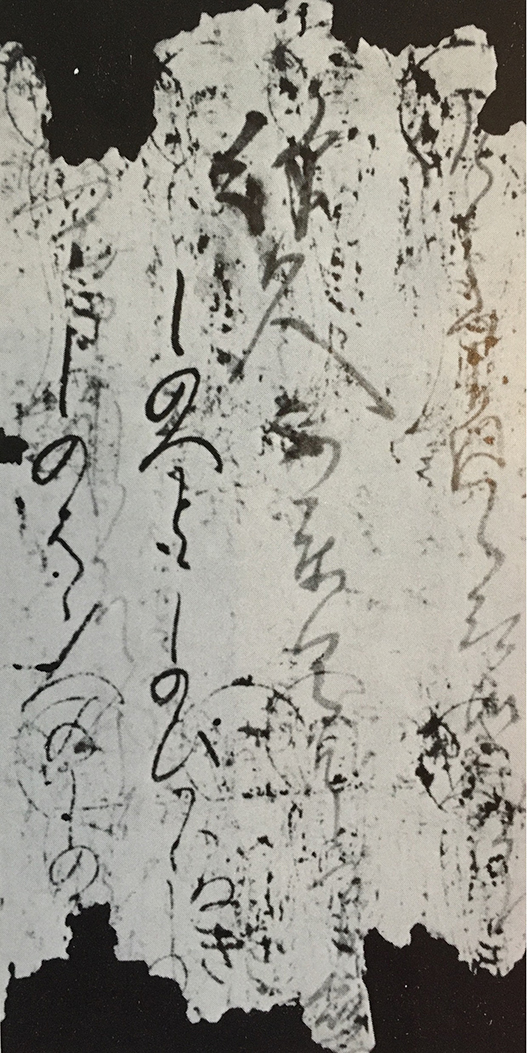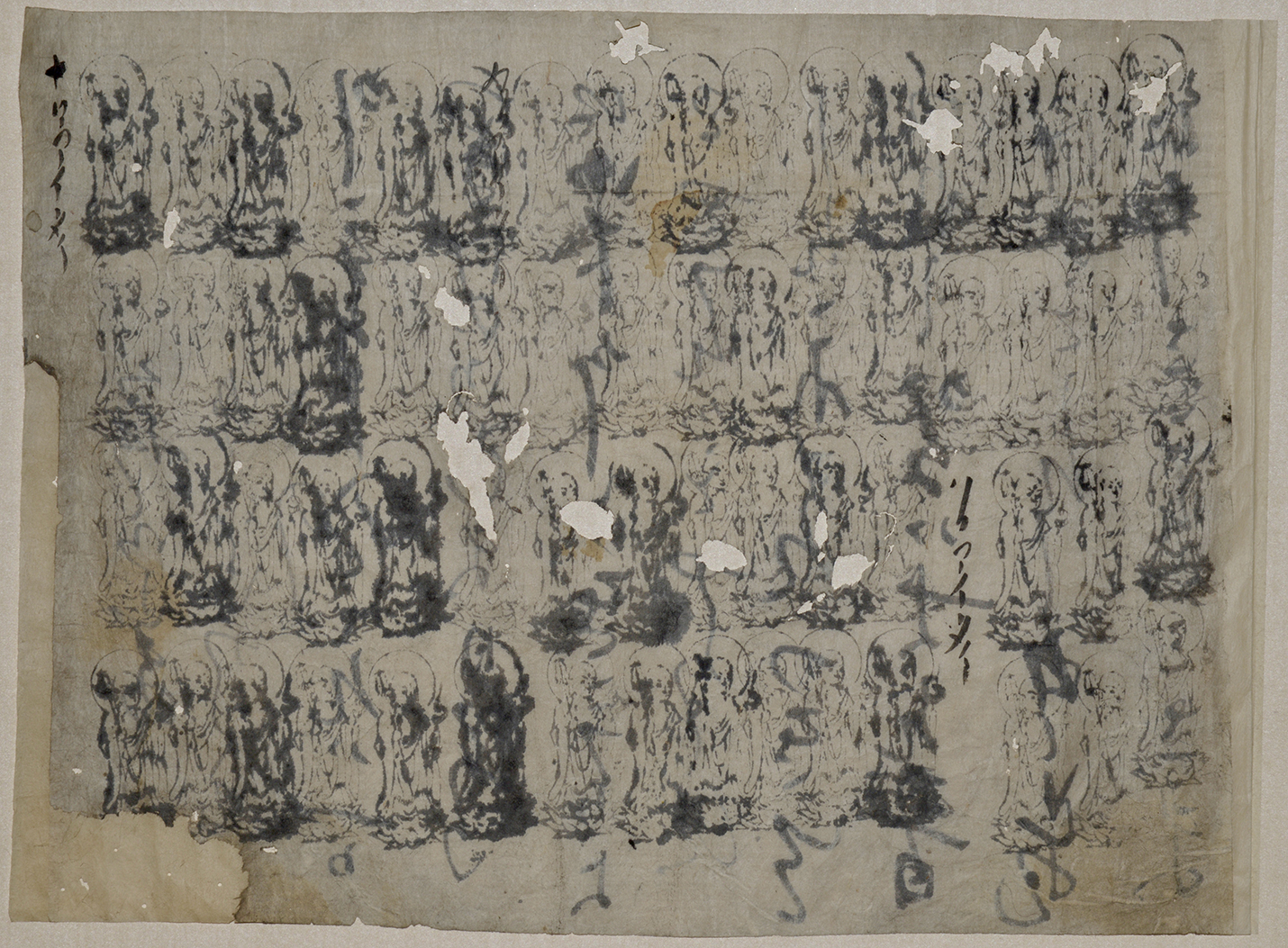Introduction
Jōgyō’s 貞暁 (1186–1231) calligraphy runs across the fragmented paper in elongated strokes that pull and abbreviate the writing (fig. 1). No longer a whole missive, the letter trails off the modern left edge of the fragment, its unity severed. Years before it was ritually stamped, the esoteric Buddhist monk Jōgyō likely wrote this letter to an unknown recipient at the start of the thirteenth century. Soaking through the back of the paper, stamped images of Amida Buddha emerge from behind the letter, creating a palimpsest of inverted figures and calligraphic brushwork. This multivalent object entered the collection of the Arthur M. Sackler Museum at Harvard in 2014 as part of the Sylvan Barnet and William Burto bequest, but this is just the latest of the manuscript’s many biographical steps. The original deposit of stamped letters attributed to Jōgyō and enshrined within the thirteenth-century standing Amida sculptural triad of Gobō Jakujōin 五坊寂静院 on Kōyasan 高野山 (Mt. Kōya; fig. 2) has been dispersed and fragmented across private and public collections in Japan and the United States.
Letter attributed to Jōgyō with images of Amida Buddha stamped on reverse, interior deposit of Amida Buddha sculpture, Gobō Jakujōin, Mt. Kōya, 13th century. H. 28.7, w. 49.6 cm. Harvard Art Museums / Arthur M. Sackler Museum, Cambridge, Massachusetts, Gift of Sylvan Barnet and William Burto (2014.150). Photograph courtesy of Harvard Art Museums
Fumiko Cranston has translated the running script of the letter (fig. 3), which discussed the unknown addressee’s acquisition of three Buddhist paintings, one of which was a hokke mandala 法華曼荼羅, accompanied by an appeal to ensure that appropriate rituals were maintained.1 A fleeting mention of the movements of an image of Fudō Myōō 不動明王, a Wisdom King known for his immovable faith and implacable drive to conquer all hindrances to enlightenment, might have referred to a sculpture Jōgyō sponsored for the Fudōdō 不動堂 of Isshinin 一心院, the temple founded by his mentor, the monk Gyōshō 行勝 (1130–1217), although the passage is too circumspect to say with any certainty.2 Gobō Jakujōin bunsho 五坊寂静院文書 records a rather complicated history of Fudōdō, including evidence of a potential first life as an Amidadō 阿弥陀堂.3 Furthermore, a passage from the circa 1719 chronicle Kōya shunjū 高野春秋 by Kaiei 懐英 (1642–1727) claims that the celebrated sculptor Unkei 運慶 (d. 1223) was commissioned to make the Fudō.4 The next section of the fragment praised Myōe 明恵 (1173–1232) and referenced a request he made, although exactly what is illegible. Jōgyō cautioned the letter’s recipient to proceed with care when dealing with such august persons as Myōe. The connections between the two well-known monks is also evidenced by Jōgyō’s invitation to Myōe in 1228 to stay the summer at Isshinin.5
While a fascinating snippet of medieval monastic dealings, the content of the letter can only take us so far in understanding the transformative practice of making stamped letters and enshrining them within an icon. Therefore, I propose to analyze the manuscript as a memorial palimpsest, tracking its creation and afterlives by paying careful attention to the material alterations marking its surface. In tracing these moments of conversion experienced by this thirteenth-century stamped letter, I use a biographical approach to think about how the object became the hanging scroll we see today and what the evidence of material reuse and contextual reinscription meant for its many functions and accumulated meanings. Within the palimpsest, Jōgyō’s handwriting is intentionally and explicitly preserved—forming a fundamental substrate of the manuscript. The continual and persistent materiality of the brushwork by the deceased is a marker of embodiment even after death, a manifestation of that person, which transitions through its reuse into what I have called a somatic signature.6 Glossing reframed handwriting as a somatic signature highlights the biographical moment when the letter was repurposed and the impact of such transformations on the signification of the writing. In other words, it captures the moment of material change and urges us to pinpoint the effects of reuse and recycling in this context. The thickly inked stamps press legibility from the letter with the overlapping and obscuring black shapes, while the trimming of the paper truncates the semantic message. In its repurposed afterlife, the paper thus ritualized becomes a site of memory and embodiment of the dead, a way of working through mourning and targeting soteriological benefit for Jōgyō through ritual action. This article, therefore, threads themes of performativity, embodied writing, and palimpsestic sites of memory and mourning traced throughout the letter’s biographical narrative, revealing the inherent tension between paper’s fragility and sacrality.
The Eventful Life of Jōgyō
Jōgyō was the third son of Minamoto no Yoritomo 源頼朝 (1147–1199), founder of the Kamakura shogunate, and Daishin no Tsubone 大進局, daughter of Date Tomomune 伊達朝宗 (1129–1199).7 The historian Wada Shūjō 和多秀乗 assembled a compact biographical portrait of Jōgyō from the sometimes contradictory and even hyperbolic primary sources that mention the remarkable life of this monk.8 When Jōgyō’s mother met Yoritomo, she was in service at his residence. Upon becoming pregnant, she was moved to a trusted retainer’s home, reportedly for her own safety amid intelligence that Hōjō Masako 北条政子 (1156–1225), the wife of Yoritomo and a powerful political figure in her own right, sought revenge for this adulterous betrayal.9 Although the tales of Masako’s jealousy may be embellished, the fear that Jōgyō seems to have experienced during his life, as evidenced by multiple moves and attempts to keep secret his location, lends some credence to the danger that Masako and the Hōjō clan possibly posed. Although Jōgyō’s mother outlived him, she seems to have played no role in his life, having been sent near Osaka to live after his birth. As a consequence, Jōgyō was cared for by Minamoto-friendly retainers during his early years. In 1192, at the age of seven, he was moved from Kamakura to Kyoto to become a novice monk at Ninnaji 仁和寺 under the high-ranking priest Ryūgyō 隆暁 (late 12th century), giving Jōgyō one of his later appellations, Ninnaji hōin 仁和寺法印. He was surrounded by powerful and cultured figures during his years in Kyoto, including the patronage of Dōhō Hōshinnō 道法法親王 (1166–1214), son of Emperor GoShirakawa 後白河天皇 (1127–1192).10
The reasons for Jōgyō’s departure from Ninnaji for Kōyasan and its date are disputed in the sources. For instance, Kii zoku fudoki 紀伊続風土記 states that he left in 1214 because of the death of Dōhō Hōshinnō,11 whereas Dentō kōroku 伝灯広録, authored by the Daigoji monk Yūhō 祐宝 (1656–1727), claims that Jōgyō left because he was angered when he was not appointed as the head of Ninnaji.12 Wada Shūjō and other Japanese historians feel that Kōya shunjū offers the most accurate description of this pivotal moment.13 This chronicle explains that Jōgyō fled Kyoto for the mountain in the third month of 1208 in order to escape the growing power in the city of Masako’s brother, Hōjō Yoshitoki 北条義時 (1163–1224).14 This account corroborates the tumultuous years following Yoritomo’s death in which the Hiki 比企, a prominent Minamoto-supporting clan, were essentially wiped out in 1203 by the Hōjō for fear that the Hiki were plotting to usurp their authority with the aid of Minamoto no Yoriie 源頼家 (1182–1204), the second shogun. The next year, Yoriie was assassinated at Shuzenji 修禅寺. With the increasing pressure and mounting hostility against the Minamoto, it seems likely that Jōgyō decided to retreat to the distance of Kōyasan.15
According to Kōyasan meisho zue 高野山名所図会, among other records, Jōgyō traveled to Kōyasan to study under the already renowned monk Gyōshō.16 However, soon after arriving, he met with Masako, who had traveled to the Kansai region to undertake the Kumano pilgrimage. Some scholars believe that this was only pretext and her genuine purpose was instead to seek assurance that Jōgyō had no political ambitions.17 In a clear detour, she stopped for a visit at Amano Shrine 天野大社 (Niutsuhime Shrine 丹生都比売神社), which coincidentally was also founded by Gyōshō.18 A different text also attributed to Kaiei dramatizes the exchange in a scene culminating with Jōgyō plucking out his left eye in a grand and gruesome gesture of loyalty.19 This extraordinary action, if it is to be believed, had the desired effect; Masako, and members of the Kamakura shogunate after her death,20 became his patrons rather than assassins. Indeed, after the third Kamakura shogun and half-brother of Jōgyō, Minamoto no Sanetomo 源実朝 (1192–1219), was murdered in 1219 on the stone steps of Tsurugaoka Hachiman Shrine 鶴岡八幡宮 by his nephew and the bettō 別当 of the shrine, Kugyō 公暁 (1200–1219),21 Masako donated the funds for the construction of Kongō Sanmaiin 金剛三昧院 as a memorial temple for Sanetomo. Jōgyō then installed Sanetomo’s remains in the hall’s main Kannon icon.22 In another possibly embellished tale akin to Jōgyō’s self-mutilation, Kōyasan meisho zue claims that after the loss of her last son, Masako solicited Jōgyō to return to Kamakura and become the new shogun, sending a letter that went unanswered and finally traveling again to Amano Shrine to implore him in person.23
Whether Jōgyō built anew or repurposed an existing building is somewhat in dispute;24 but it is clear that, with the sponsorship of Masako,25 in 1223 he founded Gobō Jakujōin (also known in the sources as simply Jakujōin) as part of a collection of five halls—hence the Gobō 五坊 prefix—reportedly based upon the five characters of the Lotus Sutra title.26 These five halls were clustered around the heart-shaped pond (shinji no ike 心字の池) that gave the overall area its name, including Isshinin, founded by his mentor Gyōshō.27 Although Jakujōin is now the only extant hall of the five, it was inside the central seated sculpture of the Amida of Jorokudō 丈六堂 that he deposited the hair relics of his late father, Yoritomo.28
The eventful life of Jōgyō was a precarious one. He was at the center of suspected intrigue, perpetually orbiting the dangerous upper echelons of the Minamoto and Hōjō clans, while also maintaining a monastic life distinguished by generous financial backing from his supposed enemies, resulting in numerous temple-building works. These newly constructed buildings filled with polychrome sculptures, ritual objects, and commemorative purpose would eventually become his own site of memorialization. The letters—gathered, stamped, and enshrined within the central Amida sculpture—ensured Jōgyō’s repose as well as his continued presence at Jakujōin. And as we know, during his life, Jōgyō participated in the same ritual of interment for his own family.
The Fragmented Lives of Letters
As part of a special issue that traces the original production of objects and their afterlives resulting from inventive reuse and recycling, this article is likewise concerned with trajectories. Framing these manuscripts as palimpsests emphasizes the modalities of experience and continued existence. Simultaneous and intentional layers impart meaning and significance to one another, even as new additions obscure older substrates. Paper’s ephemerality means that there are critical junctures in the lives of these reconfigured manuscripts, moments of endurance and retention against the odds. Perhaps because we are accustomed to seeing and studying such materials, we forget the significance of their survival across the centuries. The existence of letters from medieval Japan in the present day is quite remarkable, and one of the overarching goals of this volume is to interrogate what it means for objects and manuscripts with such storied lives—punctuated at times by destructive events—to be extant in their reinvented forms. Throughout this article, I will consider several of these critical moments in the creation and transformation of missives, stretching back to the safekeeping of letters and their re-formation after loss—a moment of rupture that causes the letter’s recipient to transform and reformulate not only the paper’s visuality but its materiality in order to layer the somatic identities of the deceased, the mourner, and the Buddha. And as is abundantly visible in the case of the Jōgyō stamped letter, its biography continued to evolve into that of a museum object remounted as a hanging scroll. Therefore, using an object biographical approach, this article emphasizes moments of transformation that reveal decisions to produce, retain, recycle, or otherwise alter handwritten letters.29
From close inspection of the letter, the paper appears to be choshi 楮紙, one of the most common types of Japanese paper, then and now. Made from the easily cultivated mulberry plant (kōzo 楮), the fibers of this paper are long and the gaps between them spacious, creating a soft surface. Because of these qualities, it is typically not suited for double-sided writing. As mentioned above, Jōgyō’s letter is not complete; it is missing content as well as a date, the name of the addressee, and the sender’s name and signature, which is why this letter and those discussed below can only be attributions, although the commonly held assumption is that other documents within the cache bore his signature. Based on the letter’s truncation, it is likely that there was a second, separate sheet. But who might have received this letter? It is written as though to a person of lower rank. Based on what we know of Jōgyō’s station and his many active projects, combined with the instructions in the missive, the recipient could have been a disciple. As this volume is dedicated to reuse, it is also important to consider in what circumstances paper was not repurposed. Despite potential scarcity, financial constraints, or simply the custom of reusing all manner of used paper, these letters were preserved, likely for several years until the critical biographical moment of Jōgyō’s death, when they were stamped, thereby converting them into a ritual object. In the meantime, where were they stored? I would argue that it would have been on Kōyasan as the recipient must have been in the vicinity of Jakujōin to contribute the letters, for there do not seem to be any extant records describing the memorial ritual. This absence suggests that knowledge of this dedication might not have been widespread. It is a curious omission, considering that multiple sources report on the enshrinements Jōgyō undertook, and one compounded by contemporaneous and later fascination with his life.
Whose hand held the seal that pressed Amida Buddha figures into the back of the paper bearing Jōgyō’s writing? Without a colophon or other records, certainty is impossible. Based on the evidence of contemporary memorial projects involving the intimacy of handwritten letters, the recipient was often the one to stamp or print the Buddhist deities or, in slightly different cases, transcribe sutra on the letter.30 Of course, another possibility is the donation of the letters after Jōgyō’s death to the temple conducting the ritual, where the monks would imprint them.31 The stamping or printing of Buddhist figures by temples, however, is more commonly seen as a method of soliciting temple donations from the lay community, and those resultant compositions focused on the accumulation of merit through the accretive abundance of stamped deities. One of the earliest surviving examples of Buddhist prints produced via such campaign donations and enshrined within an icon is an eleventh/twelfth-century printed sheet, one of many such pages discovered within the main Amida of Jōruriji 浄瑠璃寺 (fig. 4).32 As often occurs, the identity of the printed figure matched the icon within which it was deposited. The vast number of technical and visual varieties within this tradition meant that a page could be stamped repeatedly with a wooden seal bearing one or multiple figures or printed using a woodblock carved with as many as one hundred deities, known as suribotoke 摺仏, as is the case with this Jōruriji illustration.33
After the letters’ transformation into a memorial object, they were installed within the central Amida sculpture of Jakujōin sometime after 1231. They remained in that location until 1923 when the sculpture was restored and its contents removed.34 Several of the objects were sold, although exactly what and when remains unclear.35 Matsuda Hikaru 松田光 was among the first to study the cache of stamped letters after they were sold to Tanryokudō 丹緑堂 in Tokyo. Matsuda explains that the now-fragmented sheets were originally formatted as three small scrolls joining together multiple sliced letters stamped on their verso.36 The truncated stamps to the recto’s left edge combined with the discoloration caused by aged paste along both vertical edges materially confirms a handscroll format in a previous life. The first scroll was composed of thirty sheets with one-thousand stamps, the second of fifteen sheets with two-hundred stamps, and the third of thirty-two sheets with five-hundred stamps.37 In order to fit inside the diminutive Amida sculpture, Jōgyō’s letters were bisected horizontally, creating two halves of each missive, a scar still visible in the center of the reconstructed paper today. These narrowed fragments made of cleaved letters were then pasted together into a scroll format without regard for the letter’s integrity. Afterward, this scroll was stamped with two rows of repeating Amida figures.38 Close scrutiny of the Amidas filling Jōgyō’s letter suggests a single-figure seal (fig. 5), which is confirmed by the hundreds of single Amida Buddha slips also discovered within the same cache (fig. 6).39
The very reformulation of the letters into these curiously incomprehensible scrolls further verifies that the fragmentation and reuse of these missives decidedly divorced the handwriting from its original purpose. In the hands of Tanryokudō, these scrolls experienced yet another rupture when the papers were painstakingly separated from one another, thereby re-fragmenting the scrolls in order to re-create their original appearance as whole missives by pasting together the sliced halves of the letters.40 Matsuda’s testimony is further confirmed by the materiality of these reassembled manuscripts. Rejoining the two disparate halves created a slight misalignment in the calligraphic strokes of Jōgyō, material evidence that the bisection occurred after the letter’s composition (fig. 7). In looking at the pattern of stamped Amidas on the previously severed bands, it is easy to discern that the first rows are much darker than their counterparts. The density of the ink suggests a design of vertical stamping. Having freshly pressed the stamp into the ink, the first imprints on the top rows are typically darker, full of rich black color. Without replenishing the seal’s ink, the next figures are stamped on the bottom rows, leaving behind fainter Amidas. These figures never cross the restituted horizontal break running across the center of the sheet, also indicating that the letter’s segmentation occurred before the ritual stamping.
Furthermore, the consistency of the reassembled fragments across the extant documents discovered within the Jakujōin Amida sculpture explored below prove that these reconstructions to the paper were all done in preparation for the modern art market. Reassembling the two halves of these letters to re-create the original missive is in itself a restoration to a previous iteration in the letter’s biography, revealing the dealer’s system of economy at work; it is a choice that indicates the ritual scroll was deemed less likely to sell than the reconfigured letter. Fundamentally, these transformations reveal the shifting values of the letters across time, from missive to fragmented and memorialized paper to restituted art object. In any case, we are only seeing a fragment of a richer, larger project. While fragmentation means a perpetually limited glimpse at the lost whole, it also represents survival of a trace that can still reveal the praxis and material culture of centuries before.41 Edward Kamens conceptualizes fragmentation in the context of a compendium made of calligraphic samples in his article within this issue.
When Tajima Mitsuru 田島充 of London Gallery, Tokyo, acquired the stamped letter(s), they likely needed restoration. Most certainly several of the repairs done to the letter are modern. Visible behind the miniscule crack in the horizontal seam and along the edges of the palimpsest is an incredibly thin stabilizing paper added to the back of the letter. A standard practice in manuscript restoration, it makes the letter more presentable to buyers and ensures the integrity of the fragile, original paper.42 We can surmise these repairs happened before Sylvan Barnet and William Burto purchased the stamped letter in 2004, as their records do not contain any discussion of restoration plans. The correspondence between Barnet and Burto and London Gallery indicates that the collectors were keen to have the letter remounted as a hanging scroll but were concerned that doing so would both damage and obscure the stamped verso. A sensitive solution was reached by fashioning a viewing window on the reverse of the mounting (fig. 8). Along the back is another thin and almost transparent lining paper, for the viewing window necessitated further support for the letter, which could not bear the weight of itself as well as the layers of mounting. All of these transformations embody what Tanya Uyeda has described as the kinetic nature of formats.43
This contemporary biographical moment materially manifests a new afterlife for the original letter, transitioning from missive to ritual object to art display.44 The gray-brown mounting paper around the letter looks to be sourced from the backs of twentieth-century folding screens in the shibui 渋い aesthetic. This reuse of older papers from restored or retired screens is evident from the oxidized silver squares, the apparent age of the paper, and the subtle, monochromatic color. The creased brown paper at the top and bottom of the mounting also appears to be reused from a previous and now diverted life. These many material transformations speak to the ubiquitous practice of reuse and recycling across Japanese visual and material culture.
The contemporary artist and collector Sugimoto Hiroshi 杉本博司 is known for his creative reuse of older materials such as cloth and paper in the mounting of his own work and the works within his collection.45 In fact, Sugimoto staged an exhibition at the Hosomi Museum 細見美術館 in Kyoto in the spring and summer of 2020 on his theories of and experiences with using repurposed materials for mountings, what he terms Sugimoto hyōgu 杉本表具 (Sugimoto mounting). As it happens, he displayed a reconfigured letter attributed to Jōgyō from his personal collection at the exhibition (fig. 9). The gray and silvery papers of the mounting were salvaged from a previous art object, and now began life anew as the support for a likewise repurposed letter.46 Across the recto is the fluid hand of Jōgyō, and as in the letter at the Sackler, Jōgyō writes again of meeting Myōe. The letter is undated, unsigned, and unaddressed, but given the handwriting, and Tajima’s assurances that this manuscript also came from the same Jakujōin cache, this example expands the range of memorial rituals conducted for Jōgyō. Instead of stamped Buddha figures, handwritten text covers the verso. Ten nenbutsu 念仏 (homage to Amida Buddha) are clearly discernable along with tight rows of writing. Previously unidentified, it was clear this was a Buddhist scripture once I reversed the image, and I was able to identify it as a copy of Kanmuryōjukyō 観無量寿経 (fig. 10). This example should therefore be classified as a related yet distinct type of memorial palimpsest, that of the letter sutra (shōsokukyō 消息経). Much like stamped letters, letter sutras were fashioned from paper containing the handwriting of a deceased loved one with scripture copied or printed across either the recto or the verso. The transformation of the missive into a palimpsest is, therefore, clearly intentional.47 Lucia Dolce’s article in this volume also deals with palimpsestic writing.
Just like the Sackler example, the letter had been bisected horizontally and formed into a small handscroll before being reunited as a hanging scroll in the modern era. Because of these physical ruptures, the sequence of the text starts in the upper register and flows from right to left, concluding in the bottom half, which is followed by the nenbutsu. This transcription pattern further convinces me that the alteration, which split and then rejoined the two halves of the paper, was done prior to the letter’s conversion into a memorial object. This letter sutra, however, does not offer the entirety of the scripture; indeed, it is roughly the middle third. After locating another related fragment wherein the same sutra is transcribed on the verso of a brief letter attributed to Jōgyō (fig. 11),48 I suspect that what we are witnessing are the practices of a community in mourning. Most likely, they were a monastic group on Kōyasan who knew Jōgyō well; and possessed of his correspondence, the knowledge and tools necessary for funerary rituals, and a religious responsibility to conduct services for his welfare in death, they set about creating memorial palimpsests through the reuse of his handwritten letters. The copying of the sutra was perhaps assigned to a small group who divided the salvific text into parts (thirds?) and, using his letters, created these partial transcriptions that continually recall the now-dispersed whole, much like his scattered letters.49 We might consider that the collective stamping of Amida figures in the Sackler example and those discussed below worked likewise. This is a revealing discovery not only for understanding the range of contents enshrined within the Amida for Jōgyō’s memorial but also for appreciating the different types of manipulations, fragmentations, and palimpsestic layers at work for the benefit of this famous monk.
Letter attributed to Jōgyō with Kanmuryōjukyō on reverse, interior deposit of Amida Buddha sculpture, Gobō Jakujōin Mt. Kōya, 13th century. H. 28.3 cm, w. 44.4 cm. Private collection, Japan. From Kanazawa Bunko, ed., Butsuzō kara no messeeji: zōnai nōnyūhin (Yokohama: Kanazawa Bunko, 2011), entry 18
Five further examples of stamped Jōgyō letters are known from museum and private collections. The Mary and Cheney Cowles collection acquired a stamped Jōgyō letter mounted as a hanging scroll from the Mika Gallery, New York, in 2014 and have promised it as a gift to the Metropolitan Museum of Art, New York (fig. 12).50 The Cowles also gave to the Portland Museum of Art a second mounted stamped letter that matches the handwriting of Jōgyō as well as what appears to be the same production method (fig. 13).51 Another example mounted as a hanging scroll resides in a private collection in Seattle (fig. 14).52 This hanging scroll appears to have been purchased from the appraiser and dealer of Asian Art Sebastian Izzard, during an exhibition in his gallery of some of Tajima’s holdings.53 Moreover, there is evidence of a Jōgyō stamped letter mounted as a hanging scroll in a private collection in Japan.54 Finally, an unmounted fragment of a Jōgyō stamped letter is also housed in another private Japanese collection (fig. 15).55 Based on the similarities of brushwork, identical Amida figures, the pattern of fragmentation, and assembly with the telltale discolorations from the paste along the letters’ edges, compounded by the dealers’ provenance information (explicitly stated in the examples of the Cowles and Seattle private collections), we can be confident that these stamped letters originated from the same memorial cache assembled on Jōgyō’s behalf.56
Letter attributed to Jōgyō with images of Amida Buddha stamped on reverse, interior deposit of Amida Buddha sculpture, Gobō Jakujōin Mt. Kōya, 13th century. H. 27 cm, w. 41.9 cm. Metropolitan Museum of Art, Gift of Mary and Cheney Cowles (2020.396.3). Photograph courtesy of Metropolitan Museum of Art
The Mingling of Stamps and Letters
To understand the significance of the re-inscription of Jōgyō’s letters, I would like to contextualize the key issues at the heart of this memorial practice by exploring other examples of stamped letters. They represent important nodes on the complex web intertwining death, writing, and the creative reuse of paper in commemoration and mourning in medieval Japan. There are hundreds of extant examples, and the number grows with advances in imaging and as sculptures require restoration; therefore this article selects those that share the visuality and materiality of the Jakujōin cache as well as those that emphasize shades of mourning particular to the ritual practice of repurposing handwritten letters and fragments.
First, it should be acknowledged that letters are not the most common type of surface used for imprinting Buddhist deities. The combination of handwritten text with stamped images most frequently manifests as lists of names that fill one side of the paper with stamps covering either one or both sides. These are usually the names of donors, members of the monastic and lay community, and lost loved ones for whom merit is sought. The Kenkōin 遣迎院 Amida sculpted by Kaikei 快慶 (late twelfth–early thirteenth century), dated to 1194 based on the interior documents, offers an important reflection on this practice. Deposited within this sculpture were seven bound bundles of stamped kechien kōmyō 結縁交名, wherein an individual’s name was transcribed on the reverse of a stamped Amida image (fig. 16). Such registers record the names of sponsors and participants as well as the names of those unaffiliated with the project but to whom spiritual benefit would be passed. In his conclusive study, Aoki Atsushi attempts to trace the twelve-thousand recorded names, revealing both the forgotten and the notable involved in the sponsorship of the sculpture.57 Poignantly, the names of the dead also fill the backs of the paper like narrow memorial tablets (sotoba 卒塔婆) submitted by those in grief, such as that of Kujō Kanezane 九条兼実 (1149–1207) for his son, Kujō Yoshimichi 九条良通 (1167–1188). But other names of the dead are recorded for different purposes, sponsored by the victorious in order to appease the war dead and prevent spectral retribution, as is the case with the many names of the defeated and slain Taira family.58
With its focus on handwriting, the nenbutsu kechien kōmyō 念仏結縁交名 (community of nenbutsu practitioners) recorded on the backs of letters written by Pure Land priests such as Hōnen 法然 (1133–1212) (fig. 17) and then deposited within an Amida icon at Kōzenji 興善寺 in Nara (fig. 18), also attributed to Kaikei, offers a variation that brings us a step closer to the formula we find in Jōgyō’s stamped letter.59 Three handwritten letters by Hōnen and two by his disciple Shōkū 証空 (1177–1247) were sent to the Jodō disciple Shōgyōbō 正行坊.60 The letters themselves are undated, but based on the lifetimes of those whose names fill the reverse of the missives, the project corresponds to the Genkyū era 元久年間 (1204–1206).61 In total, the full names of 1,548 people were listed in rows of three to five.62 While the exact context of the palimpsests’ production is unclear, these repurposed letters creatively forged a direct link between those named and the beloved Hōnen via his brushwork, and furthermore ensured their entangled afterlives through perpetual enshrinement.
This karmically rich and personalized repurposing of letters sealed with stamped Buddhist figures is often seen in connection with memorial projects dedicated to one particular person, much like Jōgyō’s. The sculptures enshrining these poignant documents, however, did not always originate at the time of the deposits, once again revealing the multifarious afterlives of icons as is suggested by Samuel Morse’s and Hillary Pedersen’s articles in this volume. The fierce Fudō Myōō, the main icon of the Fudō Hall of Takahata Fudōson Kongōji 高幡不動尊金剛寺 in Hino, is believed to have been sculpted in the Heian period (794–1185), having been moved from an earlier site to its present location. Discovered within the neck of this sculpture were sixty-nine bundled documents, fifty of which were written by the warrior Yamanouchi Tsuneyuki 山内経之 (d. 1339) to his family members back home as well as to the monks of Takahata Fudō (fig. 19).63 Writing from the battles of Hitachi province, his correspondence described the distressing circumstances of the siege that would eventually claim his life, and at times expressed a desperate sense of loneliness.64 After his death, these letters were fragmented and rather sporadically stamped with the figures of Fudō and Daikokuten 大黒天, the patron deity of agriculture, wealth, and good fortune, and enshrined within the sculpture.65 Such practices rely on the written presence of the writer embedded within the paper and the salvific power of the palimpsested stamps to be ritually effective. While the letters speak to the affection and concern Yamanouchi felt for his loved ones’ welfare, these stamped letters are also evidence of the duty of his family and the monks who received his wartime missives to ensure his peaceful repose, particularly because he died in battle.
Perhaps as this memorial practice begins with personal letters, it is not surprising that we find evidence of extreme mourning in the techniques of production as well as tender expressions brushed by the person left in grief on the backs of the letters they stamped. Inside the Amida sculpture of Kōgyōji 光行寺 in Hyōgo, 17,497 tiny (3 cm), closely clustered, stamped Amida figures cover the surfaces of numerous handwritten letters (fig. 20). According to the dedication, the monk Enkū 円空 undertook this extraordinary memorial project for the nun Kakuchi 比丘尼覚智 in 1239 to cleanse all the sins from her first day of life to her last. Each of the 17,497 stamps thus corresponds to every day she lived: all forty-eight years, seven months, and seven days.66 As astonishing as this project is, there exists another using the same technique. Within the Amida sculpture of Osaka’s Daitsūji 大通寺 (fig. 21), letters and other documents written by Fujiwara no Chikayuki 藤原親行 (d. 1203), an official with close relations to the noblewoman and poet Hachijōin 八条院, were gathered in preparation for a monumental stamping effort. A total of 17,482 Amida stamps fills the fronts and backs of his letters, many of which discuss issues related to territorial transfers (fig. 22).67 Every day of Chikayuki’s forty-nine years is thereby quantified, visualized, and expunged of sin.
Expressions of enduring grief are sometimes brushed onto the letter itself, presumably during the process of stamping Buddhist figures. A badly damaged fragment of a letter, thought to have been written by a woman based on the hand, with a date of 1387 on one of the associated documents conveys the privacy of this type of memorial ritual (fig. 23).68 Across the back of the letter, a mourner not only stamped Jizō 地蔵 figures but was also moved to write in stark black ink a fragmentary verse, “Even though I remember, it is difficult to endure, if I recall, I can remember her, I remember.” The verse does not appear in Kokka taikan 国歌大観, suggesting that it is indeed an original, heartrending composition.69 I have based my translation on the interpretation that the author of this verse intended to manipulate the nuances of the verb shinobu しのぶ, which means “to long for,” “to remember or recall,” and “to endure.”
In a fifteenth-century example redolent of the longing that characterizes mourning, a boldly brushed mantra on the reverse of a letter bearing the signature Nobutoshi 信俊 reads, “I long to see you” (aitai アイタイ) (fig. 24). After every twenty-four Jizō stamps, this phrase—brief but saturated with longing—was written. Along with this thickly inked mantra was a daily counter for the ritual, nikka kuyō 日課供養 (printing or stamping images each day),70 in effect visualizing a calendar of grief. And because handwritten text provided a point of access for those bereft, these two phrases, shinobu and aitai, read as private declarations to the dead that treat the letter as a tangible connective tissue between the realms of the living, the deceased, and the Buddhas. These poignant manuscripts are evidence of the need to find occupation in mourning:71 to channel grief into something productive in the hope that these outlets will consume the mourner, distracting from the grief but also offering meaning and purpose in the actions. These last palimpsests, therefore, merge Buddhist stamps with two layers of handwriting and, with this ritual act, visually achieve the practically impossible: permanently and intimately blending the mourner and deceased despite the estrangement of death.
The reuse of the above letters brought a level of intimacy and somatic possibilities, augmenting and personalizing standard sutra transcriptions and printing done for memorial rites. Letters were kept for years, and after the author’s death, the biography of these papers took on additional significance, transitioning from missive to memorial object as described throughout this article. Many diaries of the time capture this conflation of self with handwriting and, by extension, paper as a site of memoria. Letters in particular seem to drive home the realities of absence after death. Lady Daibu 大夫 (ca. 1157–after 1233), writing at the catastrophic turn of the thirteenth century, described in her poetic memoir, Kenreimon’in Ukyō no Daibu shū 建礼門院右京大夫集, her grief at the loss of her love Taira no Sukemori 平資盛 (1161–1185) in the Genpei war. In an effort to process her mourning, Daibu turned to the ritual of letter sutras, creating several different types.72 But before examining these, let us consider how another passage from her memoir revealed her perception of handwriting and letters as tactile sites of memory. When arranging old letters from a now distant lover,73 she selected a letter in which the absent suitor had declared an everlasting devotion that would never diminish, and on that paper’s edge, she wrote a bitter poem lamenting the fickle nature of love and calling his letters “the last traces” of him.74 Not only did Daibu explicitly conflate the writer’s essence or trace with his brushwork, she treated the paper containing his writing as a tangible space capable of boundary-defying communication. On that shared paper, through interlineated brushes, and with it their distinct voices, Daibu spoke to her neglectful lover, framing letters themselves as embodied spaces of creation and communication—with the living here, and later with the dead. This recasting of letters as interstitial spaces prefigured Daibu’s later creative reuse of letters for sutra paper.
Facing a crippling pain,75 Daibu was compelled to take his writing and do something. For instance, much like the visuals of stamped letters, Daibu drew by hand the six forms of Jizō and copied scripture on Sukemori’s missives.76 This private memorial was a haptic insertion of herself through the hand’s endeavors onto the last traces of her love, a palimpsestic union borne of the wish to join him, an impulse she later repeatedly expressed as a desire to live with him beneath the waves.77 However, scrawling various sacred verses on the backs of his letters forced her to encounter his handwriting, accelerating her grief: “his handwriting, the very words of his letters … the world went dark before my eyes and my mind numbed.”78 Her related poetic verse reads:
This tragic and traumatic event summoned for Daibu a memory from the eleventh-century Tale of Genji 源氏物語, in which Genji could not suffer the presence of Murasaki’s handwritten letters and poems and in his sorrow burns them.80 Daibu emulates Genji’s example and commits Sukemori’s letters to the fire rather than live with their stark reminder of loss: that with the cataclysm of death, one is left with little beyond these heartbreaking bits of paper. This emulation of Genji shows how grief left her utterly restless, causing her to flail about to find an established path through the pain. These actions centering on letters were intimately linked to memory embedded in the physicality of the paper—both as an access to his trace, but also as a chasm of grief that overwhelmed her. She lamented that the messages, written directly and only to her, dredged up the past. The papers were tangible recollections of a shared love, moments of intimacy and trust, laughter as well as tears and frustration; two lives fleetingly woven together and intimately theirs, drowned beneath the waves. And so she burnt them.These traces of his hand
Do but provoke in me
Yet greater wretchedness: Rather I wish
That they would fade away.79
Performative Seals and Ephemeral Paper
To close this article, I would like to consider the performativity and visuality of seals and stamping as well as the tension between the ephemerality of paper and yet its critical role in Buddhist death rituals and the importance of its tactility in spite of its precarity. The lasting marks pressed into the paper bearing Jōgyō’s writing are permanent reminders of the now invisible and intentionally temporary seal that made them. From close visual analysis of the letter, the now missing seal featured a single figure and was likely made from wood, as was typical of such objects in Japan. Regardless of its weight and tangibility, it was made as an ultimately transitory object that was nevertheless capable of fostering a connection between mourner and embodied paper in a memorializing act. Moreover, the stamp’s palimpsestic function acts as a barrier that encloses the somatic signature. This ritual of containment corresponds to the broader ontological operations at work in sculptural deposits. With the imprint of repeating Amida figures across the open expanse of the verso, the seal ensures meritorious and salvific benefits for both the person behind the seal and the deceased. It recalls the multiplicity of the Buddha and the infinite proliferation of the Buddha nature within all things.81 But the seal also serves a preventive purpose, one that engages a different dynamic of circumscription. Read in this way, the prophylactic layer of the palimpsest ensures the continued location of the embodied presence within the boundaries of the repurposed letter and, in doing so, prevents any spectral wanderings.82 Finally, the ritually embodied letter was interred inside an icon, further augmenting both the soteriological and insulating qualities of this act of containment.
The effects on the visuality of the letter should also be considered. The recto/verso dimension is meaningfully complicated by the stamped Amida figures on one side and their trace, along with the brushwork, on the other. The impression in ink on the letter’s verso creates a palimpsest, and this moment of metamorphosis via paper’s reuse is the material evidence of the letter’s rebirth as an embodied object. In its current state, the mounting choices reestablish the binary. The surface bearing the animated brushwork of Jōgyō was privileged in the letter’s conversion into a hanging scroll. And yet even when mounted as a scroll against the wall, the Amida figures refuse to be hidden. Their impression into the fibers of the verso creates a trace that reaches the recto, bringing forth the visuality of the palimpsest. Curiously, the vision we see is of Amida inverted, a specter of salvation seen through the reverse of the paper. Through this material inversion, we actually glimpse the phantom source. This is the Amida on the face of the solid seal, and through the ink’s dispersal into the substance and tangibility of the paper, the lost carving is rediscovered. Much as the trace of the stamp materially recalls what has long been lost, the handwriting performs a similar maneuver, solidifying the calligraphic trace of the absent deceased.
The evanescence of the seal also corresponds to the perishability of paper itself. The fragility of paper meant that it frequently fell victim to insects, suffered water damage, and burned quickly in fire, among other such misfortunes. Furthermore, because of paper’s status as a valuable commodity in medieval Japan, it was often intended to serve a variety of functions over the course of its lives, to be impermanent from the start—from the reuse of the verso to the recycling of its substance in order to make a new surface freed of its original writing. In this context, the preservation of the paper’s ephemeral surface reveals what is disposable (the legibility of the writing and the letter’s completeness) but also what is so valuable that it demands retention and reconfiguration into a new life. There is, therefore, a material tension between paper’s perishability and the somaticity it is asked to carry. In this way, paper’s precarity mimics fragile life, and its somatic transformation and enshrinement within the icon hint at a transcendence over loss and the finality of death. For some individuals, grief is never over and the episodic biography of these manuscripts parallels the impossibility of closure: the object in its modern, resolved state is not necessarily its last iteration. Ultimately, the integration of brush and stamp to create palimpsestic traces on and through paper itself—bearing at its core the balance of preservation and vulnerability—offers us an object perfectly re-crafted for its memorial purpose.
Acknowledgments
My interest in using reuse and recycling as a framework for analyzing Buddhist material culture began in 2013 when Sylvan Barnet and William Burto allowed me to study their collection. It was in their living room that I first saw Jōgyō’s stamped letter. It took time to return to this project, though the impact of that first experience never left me. I remain indebted to them both for their generosity and expertise and to Elizabeth ten Grotenhuis for her kind introduction and support. I am also very grateful to John Carpenter for sharing his expert insight during our exchanges while writing this article. I would like to thank the British Academy for funding this project and the Edinburgh symposium, and the Leverhulme Trust for their subvention support for the illustrations. I am grateful to Rachel Saunders for the invitation to present an earlier version of this article at the Study Day for the exhibition Prince Shōtoku: The Secrets Within in 2019 at Harvard Art Museums, and for her astute feedback as well as help in accessing the museum files. I have been fortunate to receive the guidance of three conservators over the course of this research: Penley Knipe, Philip Meredith, and Tanya Uyeda, all of whom generously shared their wealth of knowledge and fascinating insights into conservation, paper, and material reuse. Edward Kamens and Hillary Pedersen read an earlier draft of this article and offered perceptive comments that helped me refine my arguments. Andy Hom’s incisive recommendations were crucial early on. Finally, I would like to thank Sana Mirza for her excellent support, Massumeh Farhad for her discerning suggestions, and Mary Cason for her careful attention to the text.
Author Biography
Halle O’Neal, PhD (University of Kansas) is a reader in Japanese Buddhist art and co-director of Edinburgh Buddhist Studies at the University of Edinburgh. Her book Word Embodied: The Jeweled Pagoda Mandalas in Japanese Buddhist Art (Harvard University Asia Center, 2018) explores the intersections of word, image, relics, and reliquaries, as well as the performativity and objecthood of Buddhist texts. Her current work examines medieval epistolary, Buddhist palimpsests, and the reuse and recycling of material culture in Japan. She sits on the editorial boards of The Art Bulletin and Art in Translation. E-mail: halle.oneal@ed.ac.uk
Notes
- Harvard Art Museum Archives, accessed May 2019. ⮭
- Alternatively, the Fudō referenced in Jōgyō’s letter might refer to one of the last and sadly unfinished projects sponsored by the monk in 1229 before his death. Yamamoto Eigo 山本栄吾, “Kōyasan Kamakura-ki kenchiku ikō shiron: Kongō Sanmaiin tahōtō, kyōzō, Kongōbuji Fudōdō” 高野山鎌倉期建築遺構私論: 金剛三昧院多宝塔、 経蔵、金剛峯寺不動堂 (Theories on the architecture of Kamakura-era buildings: Kongō Sanmaiin tahōtō, kyōzō, Kongōbuji Fudōdō), Mikkyō bunka 密教文化 90 (1970): 17. ⮭
- Gobō Jakujōin bunsho 五坊寂静院文書, En’ō延応 1/2/8 (1239) (Kōyasan monjo 高野山文, 6:3–5). For more on the history of the Fudōdō, see Yoshihiro Narumi 鳴海祥博, “Kokuhō Kongōbuji Fudōdō” 国宝金剛峯寺不動堂 (National Treasure, Kongōbuji Fudōdō), Kenchiku shigaku 建築史学 28 (1997): 132–37. ⮭
- Kaiei, Kōya shunjū hennen shūroku 高野春秋編年輯録 (Collection of spring and autumn annals of Kōya) (Dai Nihon Bukkyō zensho 大日本佛教全書 (DNBZ), 131:128.) Fudō’s eight attendants are more likely to have been made by Unkei. For more, see Yoshihiro Narumi, “Kokuhō Kongōbuji Fudōdō,” 134; Watanabe Hajime 渡邊一, “Fudō Myōō oyobi Hachidai Dōji zō Wakayama Kongōbuji zō” 不動明王及八大童子像和歌山金剛峯寺蔵 (The sculptures of Fudō Myōō and His Eight Attendants, Wakayama Kongōbuji Storehouse), Bijutsu kenkyū 美術研究 54 (1936): 30–33; and Aoki Jun 青木淳, “Kū Amida Butsu Myōhen no kenkyū (III): chūsei Kōyasan ni okeru kesshu to no haikei” 空阿弥陀仏明遍の研究 (III): 中世高野山における結衆との背景 (Study of Kū Amida Butsu Myōhen [III]: The circumstances of congregations on Kōyasan during the medieval period), Indogaku Bukkyōgaku kenkyū 42.2 (1994): 678. ⮭
- Kaiei, Kōya shunjū, 147; Yamamoto Eigo, “Kōyasan Kamakura-ki kenchiku ikō shiron,” 17. ⮭
- Halle O’Neal, “Inscribing Grief and Salvation: Embodiment and Medieval Reuse and Recycling in Buddhist Palimpsests,” Artibus Asiae 79.1 (2019): 101–44. ⮭
- Toin Kinsada 洞院公定, Sonpi bunmyaku 尊卑分脈 (Lineages of the noble and base) (Shintei zōho kokushi taikei 新訂増補國史大系 (SZKT), 3 (60上): 297). Taira Masayuki 平雅行 cautions us that Sonpi bunmyaku, a genealogical text compiled by Toin Kinsada (1340–1399), erroneously lists the different names assumed by Jōgyō as two separate people; Taira Masayuki, “Kamakura Shingon-ha to Matsudono hōin: Yoshimoto to Jōson” 鎌倉真言派と松殿法印: 良基と静尊 (Kamakura Shingon school and the priest Matsudono: Yoshimoto and Jōson), Ningen bunka kenkyū 人間文化研究 35 (2015): 236–35 (reverse pagination). For more about Jōgyō, including his family tree, see Yamakage Kazuo 山陰加春夫, “Kōya no hijiritachi: Kōyasan Isshinin dani no baai” 高野の聖たち: 高野山一心院谷の場合 (Kōya hijiri: A case study of Kōyasan Isshinin), Mikkyō bunka 218 (2007): 57–82. For Hōjō Masako’s 北条政子 (1156–1225) displeasure at the affair, see Azuma kagami 吾妻鏡 (Mirror of the East) (Bunji 文治 2/2/26) (SZKT, 32:201); Katayama Takeshi 片山剛, “‘Uhanari,’ ‘konami’ no shosō (1): Heian jidai wo chūshin ni” 「うはなり」「こなみ」の諸相 (1): 平安時代を中心に (Aspects of Uhanari and Konami [1]: Focusing on the Heian period), Journal of Senri Kinran University 千里金蘭大学紀要 14 (2017): 137. ⮭
- Wada Shūjō 和多秀乗, “Jōgyō ryakuden 貞暁略伝” (Biography of Jōgyō), Zoku Shingonshū zensho 続真言宗全書 (ZSZ), 35: 10:1. ⮭
- Wada Shūjō, “Jōgyō ryakuden,” 1. Rather than characterize Masako’s anger in terms of adultery, a potentially anachronistic concept for thirteenth-century Japan, I am more inclined to believe it was because of the perceived threat to the direct succession of power from Yoritomo to her sons. Further evidence of Masako’s targeting the relationships of Yoritomo that resulted in children is the story of Makino Munechika burning the home of Ōe Hirotsuna, where Kame no Mae was hiding, pregnant with Yoritomo’s child (Wada Shūjō, p. 1). Wada Shūjō speculates that the disproportionate ire directed at Jōgyō stemmed from the contrast between his inherent leadership skills and the perceived lack of natural talent in her own son, Minamoto no Yoriie 源頼家 (1182–1204) (p. 2). ⮭
- Kii zoku fudoki 紀伊続風土記 (ZSZ, 40:75); Wada, “Jōgyō ryakuden,” 3. ⮭
- Kii zoku fudoki (ZSZ 39:465, 798); Wada, “Jōgyō ryakuden,” 3. ⮭
- Wada Shūjō, “Jōgyō ryakuden,” 3. ⮭
- Wada Shūjō, 3; Yamamoto Eigo, “Kōyasan Kamakura-ki kenchiku ikō shiron,” 15–16. ⮭
- Kaiei, Kōya shunjū, 132. ⮭
- Aoki Jun points out that Kōyasan at this time was a place where those affected by the instability of the Genpei War retreated, undertaking hijiri-style activities. Aoki Jun, “Kū Amida Butsu Myōhen no kenkyū,” 677. ⮭
- Kōyasan meisho zue 高野山名所図会 (Illustrated famous sites of Kōyasan), 158. https://dl.ndl.go.jp/info:ndljp/pid/819309. For more on Gyōshō, see the summary biographies in Kii zoku fudoki (ZSZ 39:802; 40:216). ⮭
- Wada Shūjō, “Jōgyō ryakuden,” 3–4 ⮭
- Kōyasan meisho zue, 155. The visit to Amano Shrine is recorded by Kōya shunjū but not the reason for it. Kaiei, Kōya shunjū, 132–133. ⮭
- Wada Shūjō, “Jōgyō ryakuden,” 3–4. ⮭
- Yamamoto Eigo, “Kōyasan Kamakura-ki kenchiku ikō shiron,” 17. ⮭
- Azuma kagami, Jōkyū 承久 1/1/27 (SZKT, 32: 747–53). ⮭
- Kii zoku fudoki (ZSZ 39:388–89); Aoki Jun 青木淳, “Kongōbuji shozō taizōkai itabori mandara no kechien kōmyō” 金剛峯寺所蔵胎蔵界板彫曼荼羅の結縁交名 (Kechien kōmyō on the Taizōkai mandara in Kongōbuji’s collection), Mikkyō bunka 196 (1997): 32. At this critical time, Jōgyō also established three still-extant gōrintō for Yoritomo, Yoriie, and Sanetomo. See Miyasaka Yūshō 宮坂宥勝, Kōyasan shi 高野山史 (History of Kōyasan) (Tokyo: Shinkōsha, 1984): 56–57. See also Kamei Kōshō 亀位公昭, “Kōyasan no sekizō kinenbutsu” 高野山の石造記念物 (Stone monuments of Kōyasan), Mikkyō bunka 51 (1960): 36–37. ⮭
- Kōyasan meisho zue, 158. This is not recorded in Azuma kagami, for instance. ⮭
- For more, see Yoshihiro Narumi, “Kokuhō Kongōbuji Fudōdō.” Kōyasan meisho zue claims that Gyōshō founded it. ⮭
- For more on the financial arrangements of Jōgyō, see Ōta Naoyuki 太田直之, “Chūsei kōki no kanjin hijiri to chiiki shakai: Kōyasan Jakujōin zōshin shōnin no katsudō o jirei to shite” 中世後期の勧進聖と地域社会: 高野山寂静院増進上人の活動を事例として (Kanjin hijiri and local communities in the late medieval period: Using the monks’ activities of Kōyasan’s Jakujōin as an example), Minshūshi kenkyū 民衆史研究 77 (2009): 4. ⮭
- Kōyasan meisho zue, 158; Kaiei, Kōya shunjū, 128; Kii zoku fudoki (ZSZ 4:464, 799). ⮭
- Kōyasan meisho zue, 158; Kii zoku fudoki (ZSZ 4:463; 5:216). ⮭
- Kaiei, Kōya shunjū, 144; Kii zoku fudoki (ZSZ 4:464, 466, 799). ⮭
- Igor Kopytoff, “The Cultural Biography of Things: Commoditization as Process,” in The Social Life of Things: Commodities in Cultural Perspective, ed. Arjun Appadurai (Cambridge: Cambridge University Press, 1986), 64–91. See also Chris Gosden and Yvonne Marshall, “The Cultural Biography of Objects,” World Archaeology 31.2 (1999): 169–78; and Janet Hoskins, Biographical Objects: How Things Tell the Stories of People’s Lives (New York: Routledge, 1998). Sherry Fowler’s article in this volume also explicitly uses object biography in the analysis of the recycling of bronze bells during wartime. ⮭
- I have adopted the terms stamping to describe the pressing of an inked seal onto paper and printing to indicate the process of rubbing a baren over the back of a piece of paper placed over an inked woodblock. ⮭
- A similar case is when Emperor Fushimi 伏見天皇 (1265–1317) gathered together the letters of his recently deceased father, Emperor GoFukakusa 後深草天皇 (1243–1304), and bid the priest Eirin/Erin 恵琳 (n.d) of Kōzanji 高山寺, Kyoto, to transcribe scripture on their backs. ⮭
- Kaneko Kazumasa 金子和正, “Heian Kamakura jidai no inbutsu suribotoke yonshu” 平安鎌倉時代の印仏摺仏四種 (The four types of inbutsu and suribotoke in the Heian and Kamakura periods), Biburia ビブリア 91 (1988): 37–43. ⮭
- Not all the sheets deposited within the Jōruriji cache were produced as suribotoke. ⮭
- According to Fukugata Akiko 福形安希子 of the Reihokan Museum on Kōyasan, one scroll of bonji 梵字 characters was reinstalled inside the Amida sculpture. Correspondence with the author, December 18, 2020. ⮭
- Matsuda Hikaru 松田光 describes an infamous scandal in which a monk from Jakujōin sold many important temple treasures, including objects from this cache, without permission in order to fund a lavish lifestyle. Matsuda Hikaru, “Bukkyō bijutsu no wakiyakutachi: inbutsu” 4 仏教美術の脇役たち: 印仏4 (Buddhist art’s supporting characters: Buddhist prints), Chiisana tsubomi 小さな蕾 564 (2015): 80. ⮭
- See the following comparative, although not bisected, examples also mounted as scrolls: Hōryūji’s Yakushi stamped letter scroll (Kikutake Junʼichi 菊竹淳一, “Bukkyō hanga” 仏教版 [Buddhist woodblock prints], Nihon no bijutsu 日本の美術 218 [1984]: 55); Hōryūji’s Nyoirin Kannon 如意輪観音 and Jizō stamped letter (Kikutake Junʼichi, “Bukkyō hanga,” 55); and Nara National Museum’s stamped Diamond Sutra and kechien kōmyō scroll (https://www.narahaku.go.jp/collection/803-2.html). ⮭
- Matsuda Hikaru, “Bukkyō bijutsu no wakiyakutachi,” 79. ⮭
- Matsuda Hikaru, 75–79. ⮭
- Machida Shiritsu Kokusai Hanga Bijutsukan 町田市立国際版画美術館, ed., Han to kata no Nihon bijutsu: sore wa takusan no kata omoi kara umareta 版と型の日本美術: それはたくさんの「カタ思い」から生まれた (Machida: Machida Shiritsu Kokusai Hanga Bijutsukan, 1997), 104. The single stamps of Amida Buddha from the Jakujōin Amida cache can be found for sale online. ⮭
- Matsuda Hikaru, “Bukkyō bijutsu no wakiyakutachi,” 75. ⮭
- For more on fragmentation, see Melanie Trede, “Lives of the Japanese Picture,” in Arts of Japan: The John C. Weber Collection, ed. Trede (Berlin: Museum für Ostasiatische Kunst und Staatliche Museen zu Berlin, 2006), 20–27. ⮭
- I am grateful to Penley Knipe (Harvard Art Museums) and Philip Meredith (Museum of Fine Arts, Boston) for their expert insight on issues of paper, restoration, and remounting as related to the stamped letter. ⮭
- Tanya T. Uyeda, “How Far Do We Go? Compensation and Mounting Choices in the Treatment of Japanese Paintings,” Book and Paper Group Annual 30 (2011): 101. ⮭
- This brings to mind ofuda お札 (paper talismans) mounted as pilgrimage souvenirs. ⮭
- Initially, I thought Sugimoto himself might have mounted the stamped letter, given his established connection with Sylvan Barnet, William Burto, and Tajima Mitsuru, and the similarities to his style of mounting and reuse. However, Haruko Hoyle ホイル治子, director of the Enoura Observatory, Odawara Art Foundation 小田原文化財団, confirmed that Sugimoto was not involved in the project. Correspondence with the author, November 27, 2020. ⮭
- Hiroshi Sugimoto 杉本博司, Rekishi no rekishi: Sugimoto Hiroshi 歴史の歴史: 杉本博司 (History of history: Sugimoto Hiroshi) (Tokyo: Kabushiki kaisha Shinsozai Kenkyūjo, 2008), 140–41. ⮭
- For an extended argument on palimpsests in a Buddhist context, see O’Neal, “Inscribing Grief and Salvation,” 9–15. ⮭
- Kanazawa Bunko 金沢文庫, ed., Butsuzō kara no messeeji: zōnai nōnyūhin 仏像からのメッセージ: 像内納入品 (Message from Buddhist sculptures: Objects enshrined within sculptures) (Yokohama: Kanazawa Bunko, 2011), entry 18. ⮭
- Collaborative sutra transcription projects were sometimes organized in this manner. Another option is that the same person transcribed the sutra in this segmented way for reasons currently unknown. ⮭
- John Carpenter, Metropolitan Museum of Art, New York, correspondence with the author, October–December 2020. ⮭ ⮭
- I would like to thank Sherry Fowler for introducing me to this example and Jeannie Kenmotsu for her help in securing the image. ⮭
- See note 50. ⮭
- Scrolls of Faith: Japanese Religious Art from the Tenth to the Fourteenth Centuries, Sebastian Izzard Asian Art, New York, March 20–March 28, 2007, https://www.izzardasianart.com/products/march-2007-exhibition?_pos=1&_sid=9e2ffd7ab&_ss=r (accessed January 31, 2022). ⮭
- https://www.instagram.com/p/Bpk8OvrH6D-/ (accessed January 31, 2022). ⮭
- Kanazawa Bunko, Butsuzō kara no messeeji, entry 17. ⮭
- There are certainly other extant examples, and given the movement of the letters through dealers, they have likely ended up in private collections. ⮭
- Within the cache, there is also a stamped letter, which Aoki Atsushi suggests was addressed to Kaikei, asking about the state of an ongoing project. He draws connections to other letters addressed to Kaikei that were interred within other Buddhist deities he sculpted. Aoki Atsushi 青木淳, Kenkōin Amida Nyoraizō zōnai nōnyūhin shiryō 遣迎院阿弥陀如来像像内納入品資料 (The materials enshrined with the Kenkōin Amida Buddha Sculpture) (Kyoto: Kokusai Nihon Bunka Kenkyū Sentā, 1999), 178–79. ⮭
- See Aoki Atsushi, Kenkōin Amida Nyoraizō zōnai nōnyūhin shiryō, 181–86, for the relationship of the Genpei War to this project. ⮭
- In a strange connection to Jōgyō, Hōnen shōnin gyōjō ezu 法然上人行状絵図 claims that Hōnen’s bones, which had been worn around the neck of Myōhen, were passed to Jōgyō for safekeeping and dedication at Jakujōin. Aoki Atsushi, “Kū Amida Butsu Myōhen no kenkyū,” 679. ⮭
- Aoki Atsushi, Butsuzō no shirarezaru nakami 仏像の知られざるなかみ (Unknown Buddhist sculpture) (Tokyo: Takarajimasha, 2013): 32. ⮭
- Shiga Kenritsu Biwako Bunkakan 滋賀県立琵琶湖文化館, ed., Butsuzō: tainai no sekai 仏像: 胎内の世界 (Buddhist sculptures: The world inside) (Ōtsu: Shiga Kenritsu Biwako Bunkakan), 82. ⮭
- Nara National Museum 奈良国立博物館, ed., Butsuzō to zōnai nōnyū hinten 仏像と像内納入品展 (Exhibition of Buddhist sculptures and their deposited objects) (Nara: Nara Kokuritsu Hakubutuskan, 1974), 72–73. ⮭
- For more on fourteenth-century battles, including analysis of some of Yamanouchi Tsuneyuki’s letters, see Thomas Donald Conlan, “The Nature of Warfare in Fourteenth-Century Japan: The Record of Nomoto Tomoyuki,” Journal of Japanese Studies 25.2 (1999): 299–330. ⮭
- For a thorough analysis of these letters, see Hino Shishi Hensan Iinkai 日野市史編さん委員会, ed., Hino shishi shiryōshū: Takahata Fudō tainai monjo hen 日野市史史料集: 高幡不動胎内文書編 (Hino City historical materials: Documents within the Takahata Fudō) (Tokyo: Hino Shishi Hensan Iinkai, 1993), esp. 90–91 for the missive mentioned here. ⮭
- Hino Shishi Hensan Iinkai, Hino shishi shiryōshū, 181–84. ⮭
- Kikutake Junʼichi, “Bukkyō hanga,” 54–56. ⮭
- Kanazawa Bunko, Butsuzō kara no messeeji, 57. ⮭
- Kikutake Junʼichi reports that this fragment was discovered inside a Jizō 地蔵 sculptural deposit at Shitennōji 四天王寺. However, in speaking with the temple, I learned that no such Jizō or related documents have been found. It was suggested that perhaps the letter was in the personal collection of one of the priests of the temple at the time of the publication. Kikutake Junʼichi, “Bukkyō hanga,” 56–57. ⮭
- My thanks to Edward Kamens for his help checking the Kokka taikan at a time when I could not access the database. ⮭
- For more on nikka kuyō, see Narita Shunji 成田俊治, “Suribotoke, inbutsu kō” 摺仏, 印仏攷 (A study on printed Buddhist images and stamped Buddhist images), Ōryō shigaku 鷹陵史学 3 (1977): 439–65. ⮭
- O’Neal, “Inscribing Grief and Salvation,” 24–26. ⮭
- Daibu produced several letter sutras using a variety of creative means, which due to space constraints are explored in greater depth in my book manuscript on this broader subject. ⮭
- The lover is unidentified in the passage but might be Sukemori. ⮭
- Phillip Tudor Harris, The Poetic Memoirs of Lady Daibu (Stanford, CA: Stanford University Press, 1980), 165–67; Daibu, Kenreimon’in Ukyō no Daibu shū 建礼門院右京大夫集, in Nihon koten bungaku taikei 80: 453. ⮭
- See for instance, Daibu, Kenreimon’in Ukyō no Daibu shū, 474; and Harris, Poetic Memoirs of Lady Daibu, 207. ⮭
- Daibu, Kenreimon’in Ukyō no Daibu shū (NKBT, 80: 475); Harris, Poetic Memoirs of Lady Daibu, 209–11. ⮭
- Daibu, Kenreimon’in Ukyō no Daibu shū (NKBT, 80: 487); Harris, Poetic Memoirs of Lady Daibu, 233. ⮭
- Harris, Poetic Memoirs of Lady Daibu, 211; Daibu, Kenreimon’in Ukyō no Daibu shū (NKBT, 80: 476.) ⮭
- Harris, Poetic Memoirs of Lady Daibu, 211; Daibu, Kenreimon’in Ukyō no Daibu shū (NKBT, 80: 476.) ⮭
- Murasaki Shikibu, Genji monogatari 源氏物語 (Shin Nihon koten bungaku taikei 新日本古典文学大系, 22: 205). ⮭
- For a recent treatment of Buddhist printing, see Hsueh-man Shen, Authentic Replicas: Buddhist Art in Medieval China (Honolulu: University of Hawai’i Press, 2018). ⮭
- For the treatment of waka as containers, see Edward Kamens, Waka and Things, Waka as Things (New Haven, CT: Yale University Press, 2017), 166–67. ⮭


